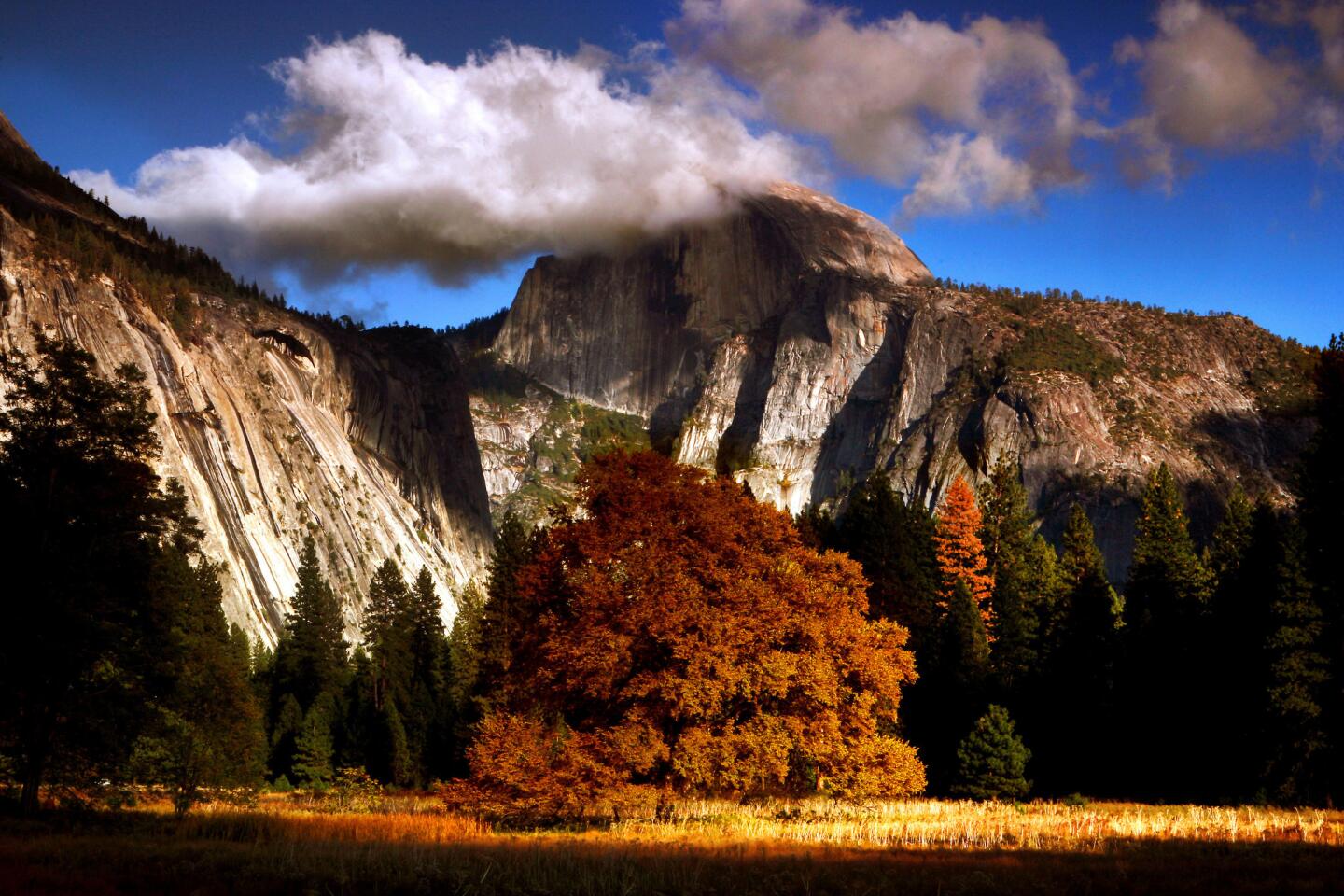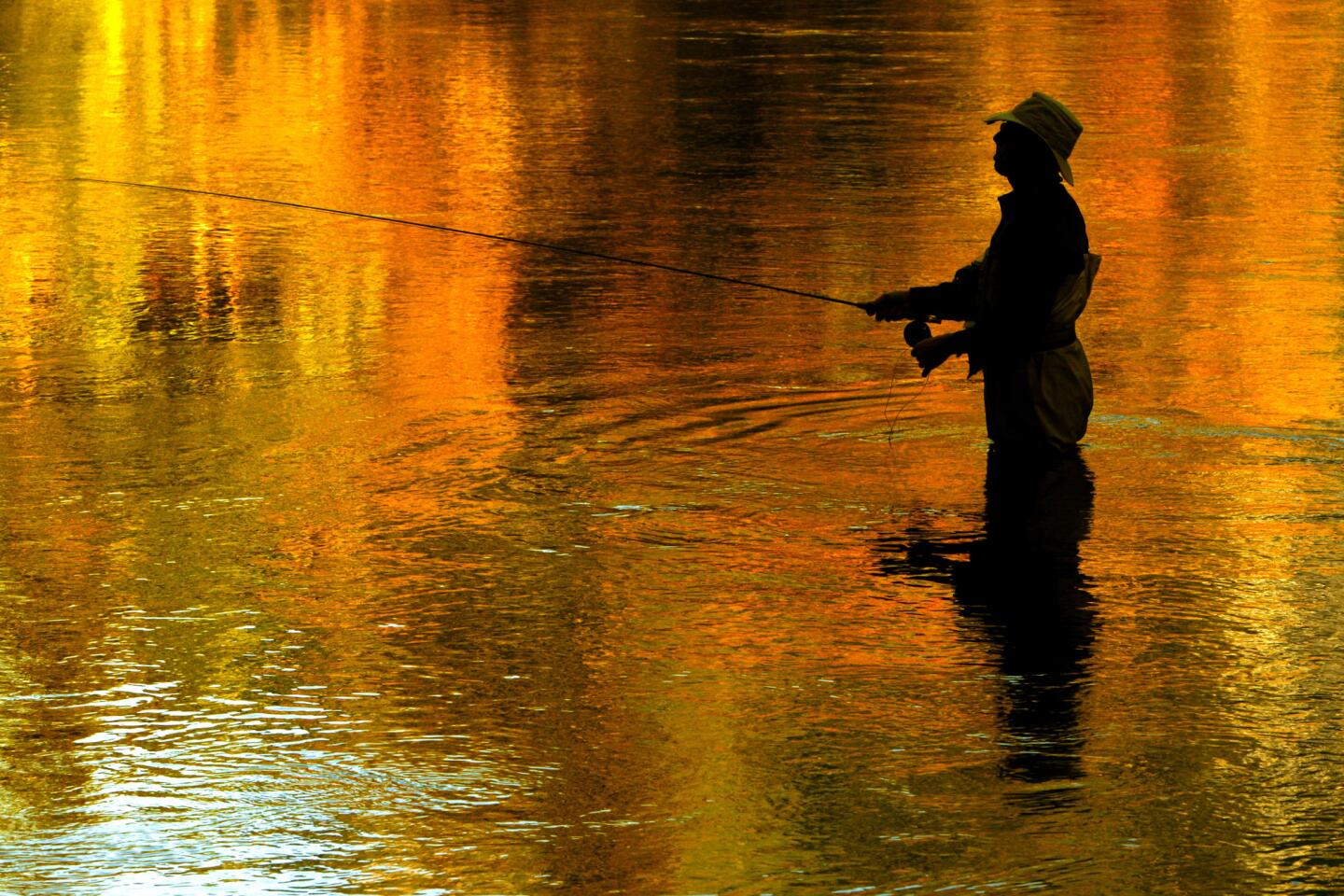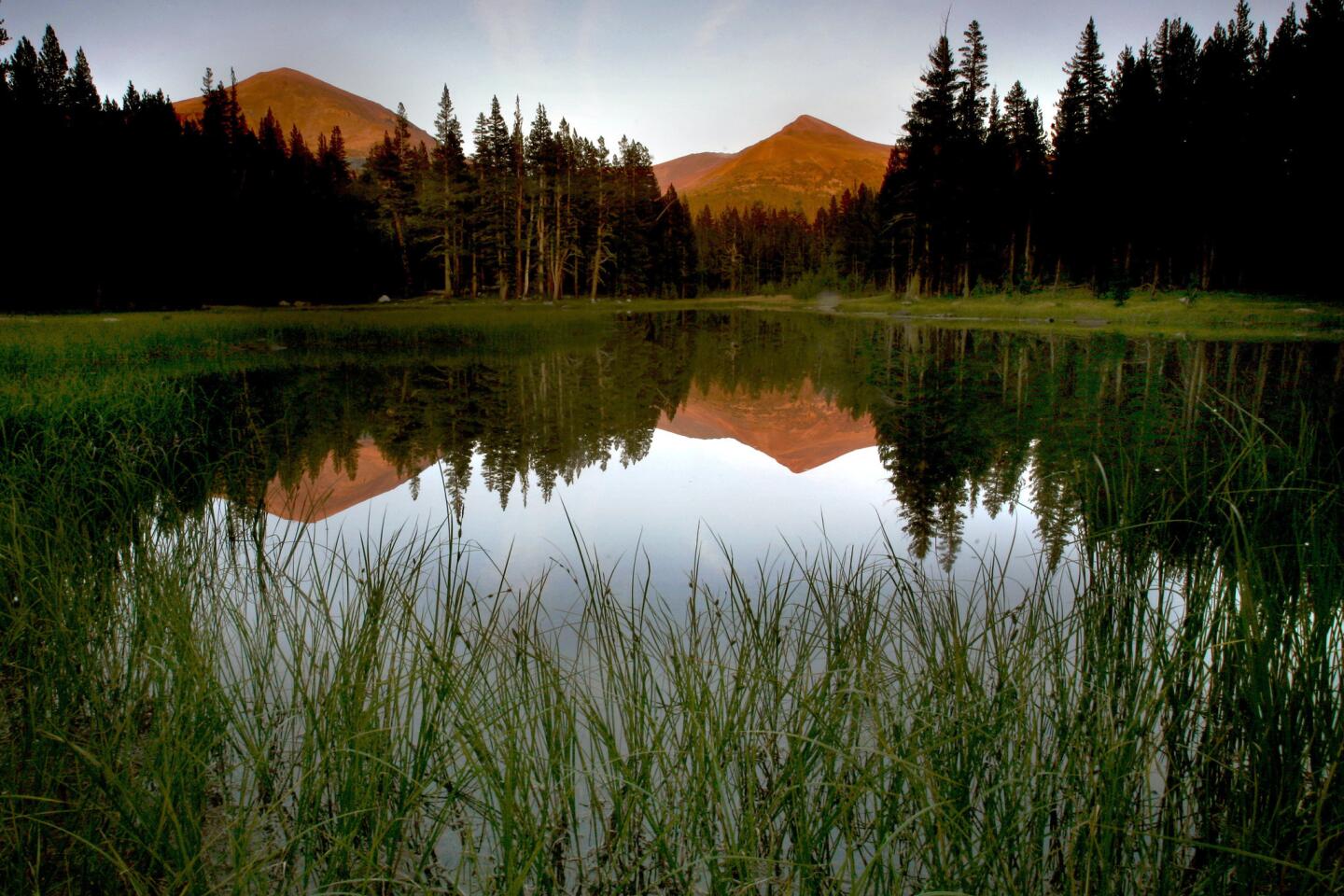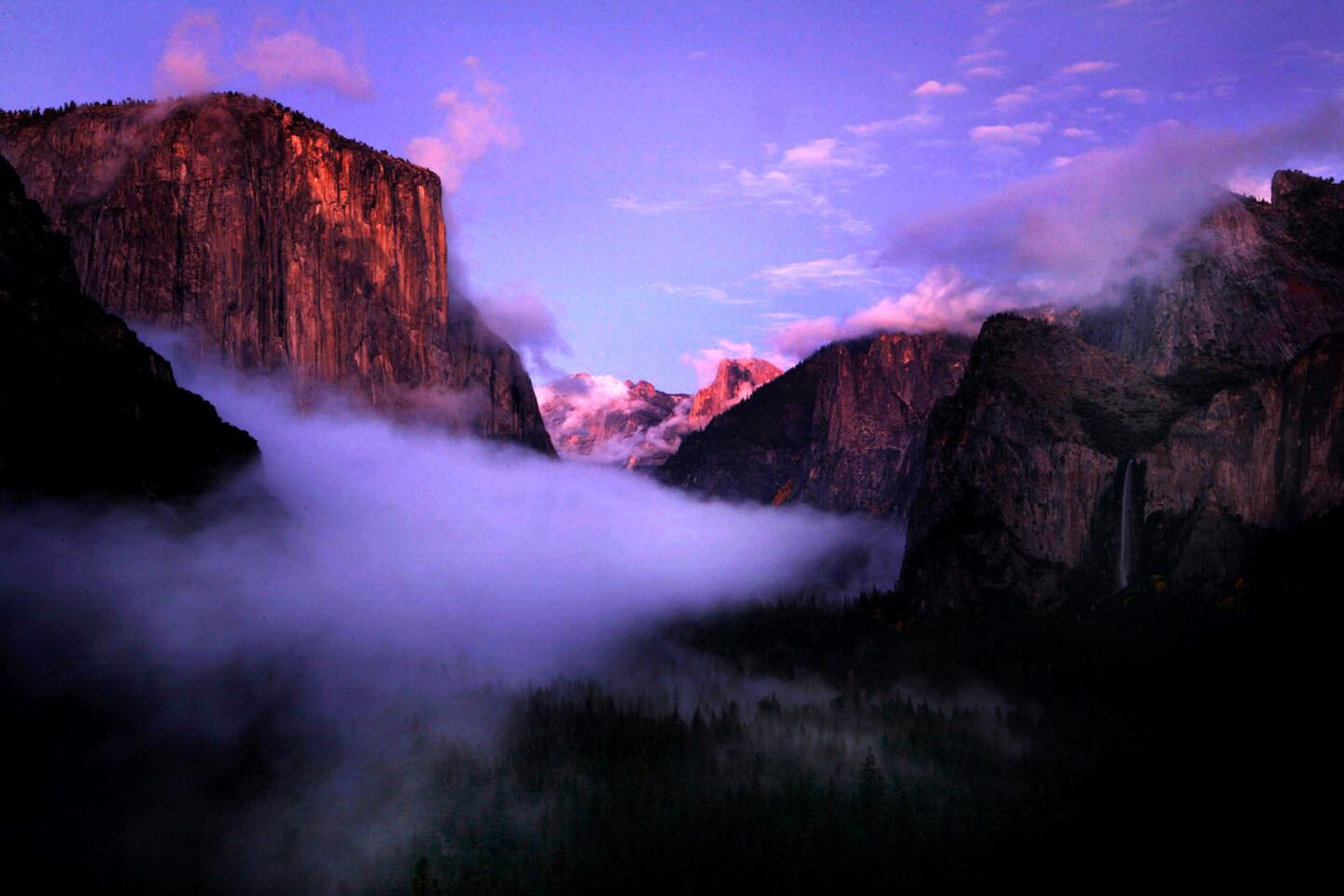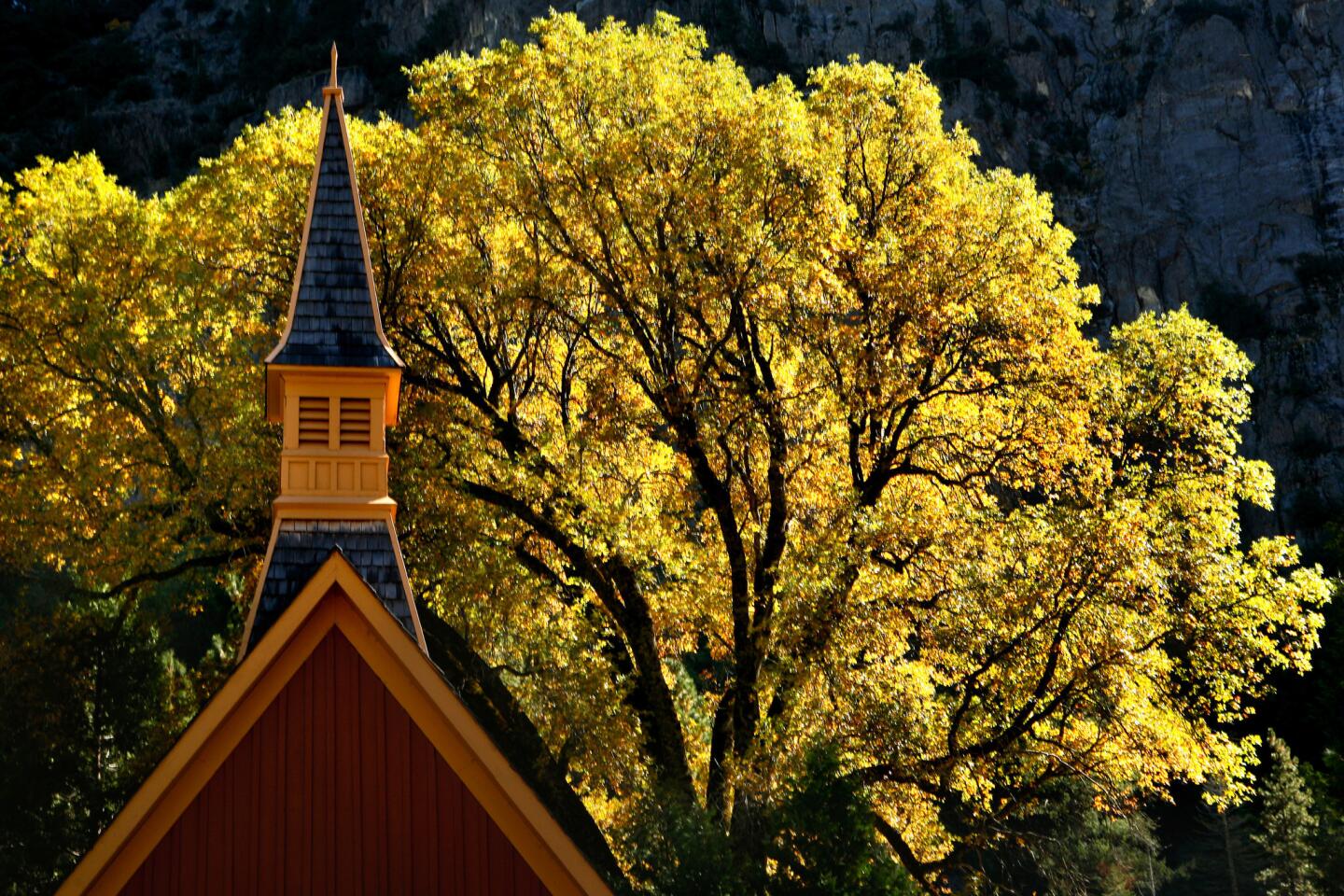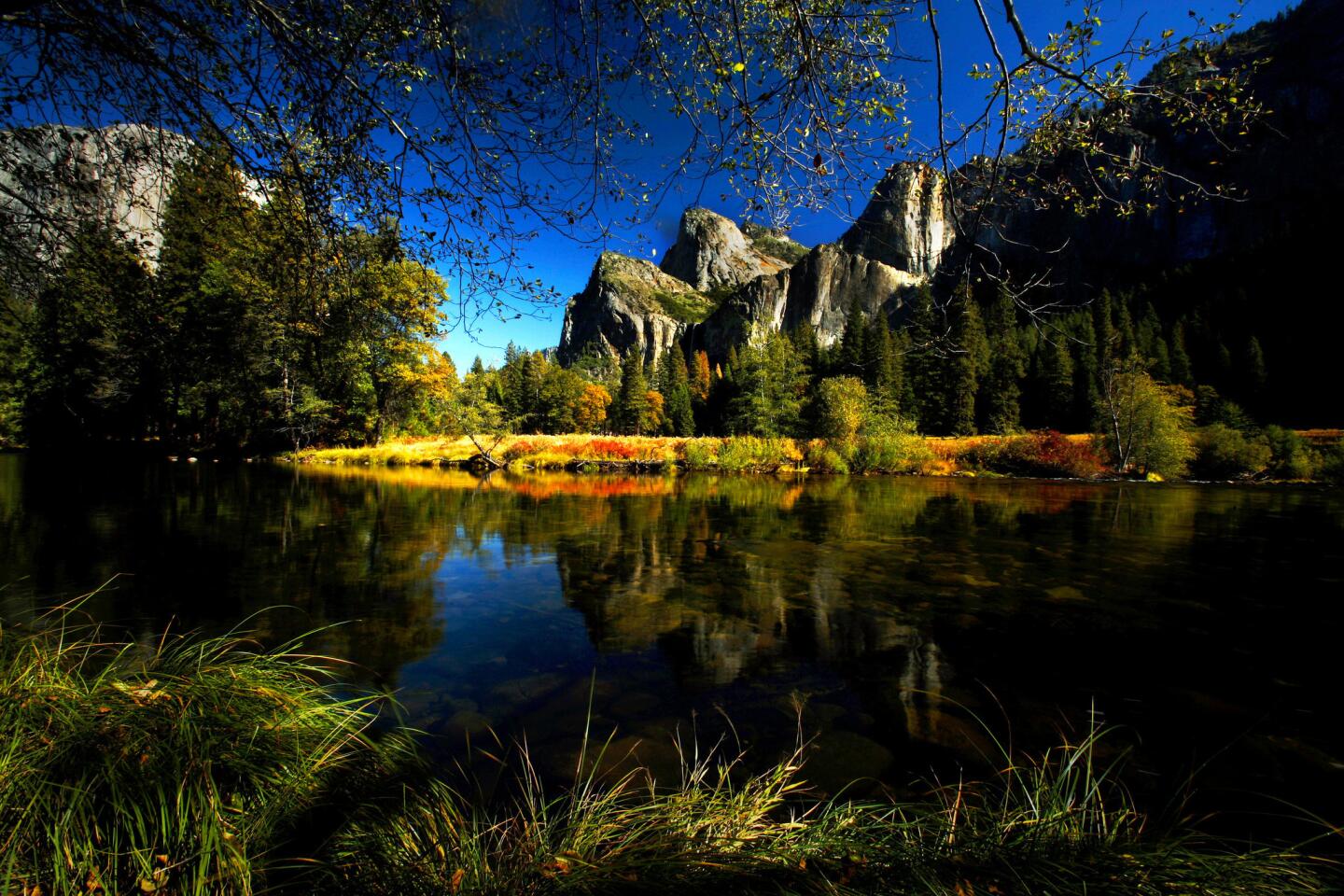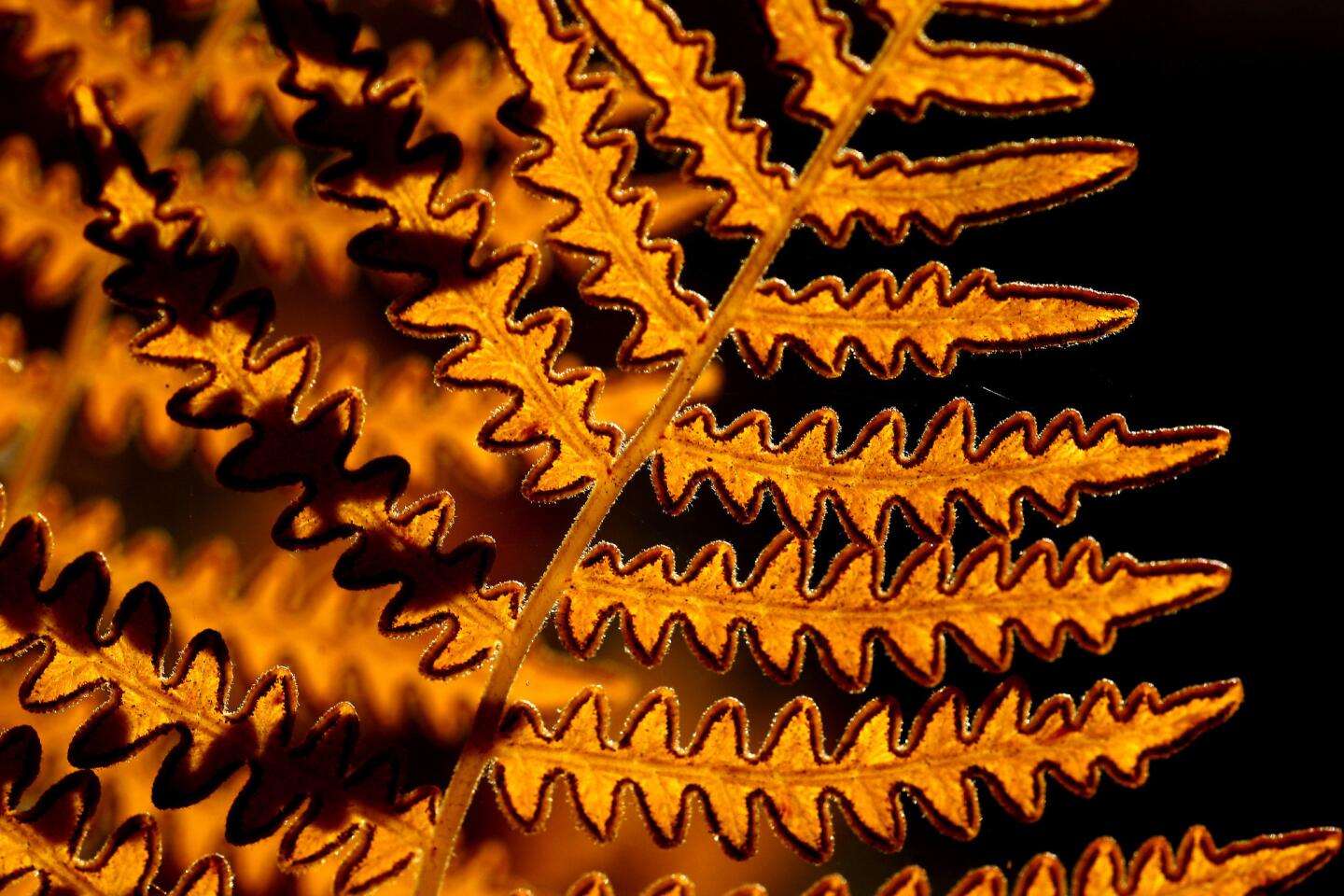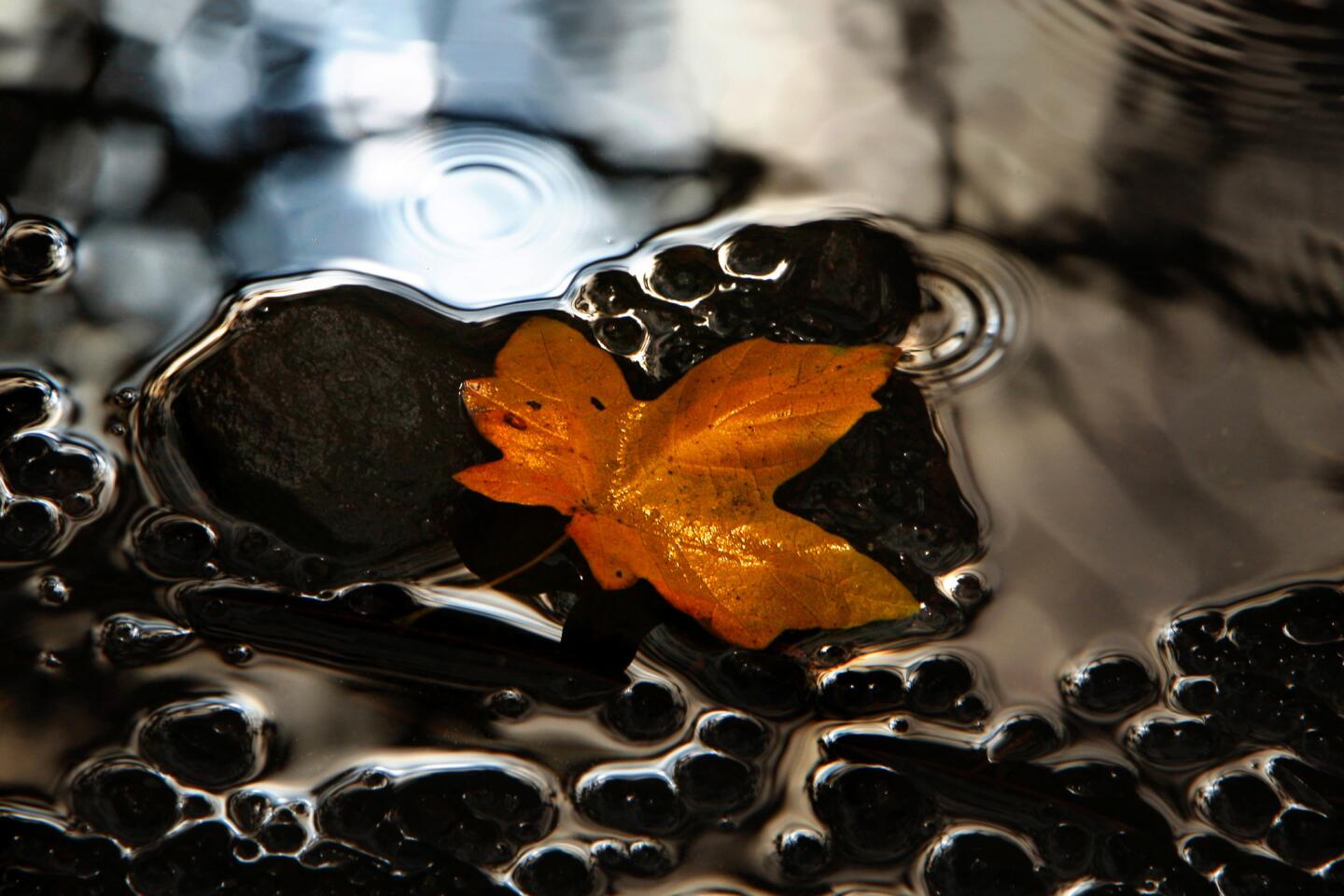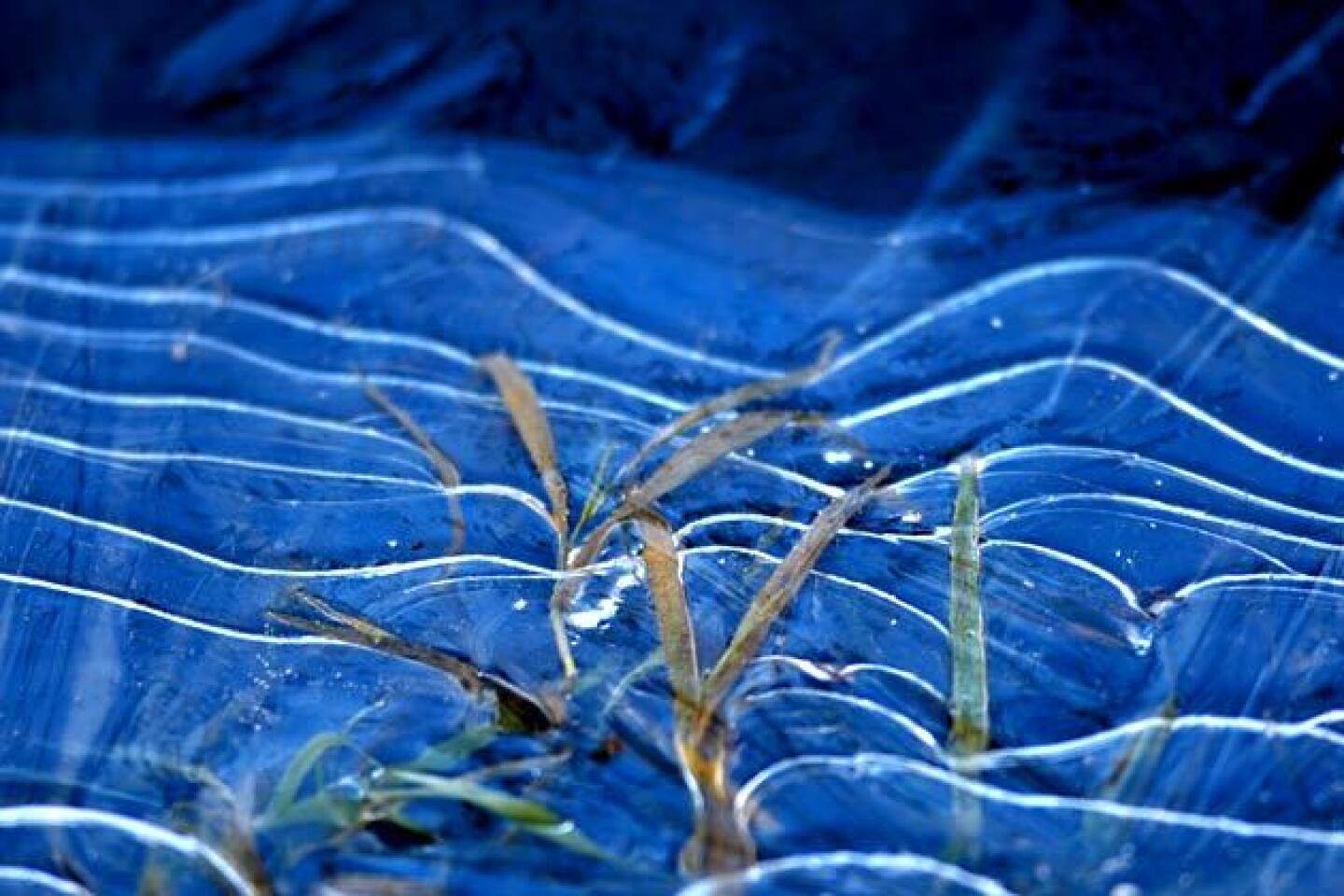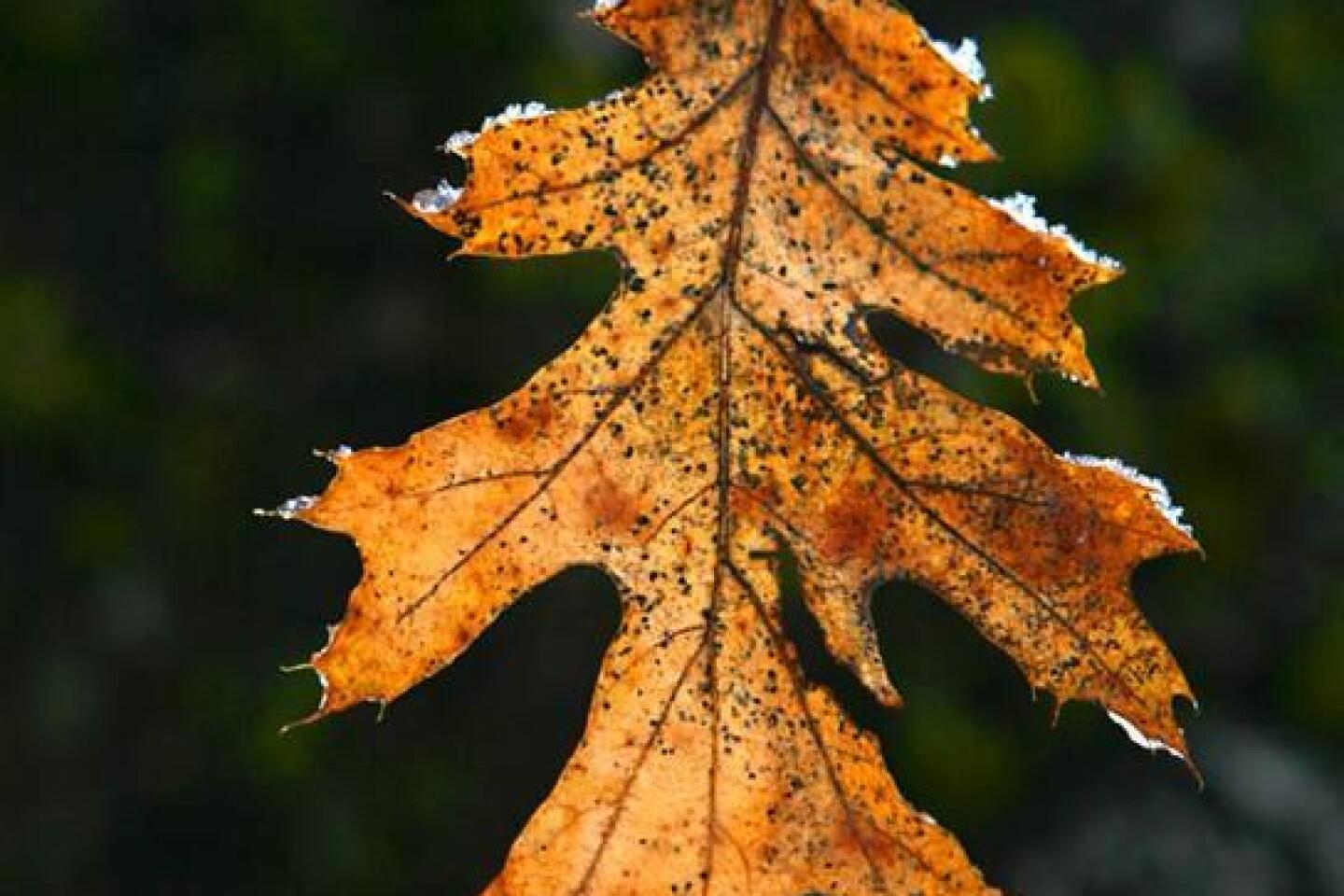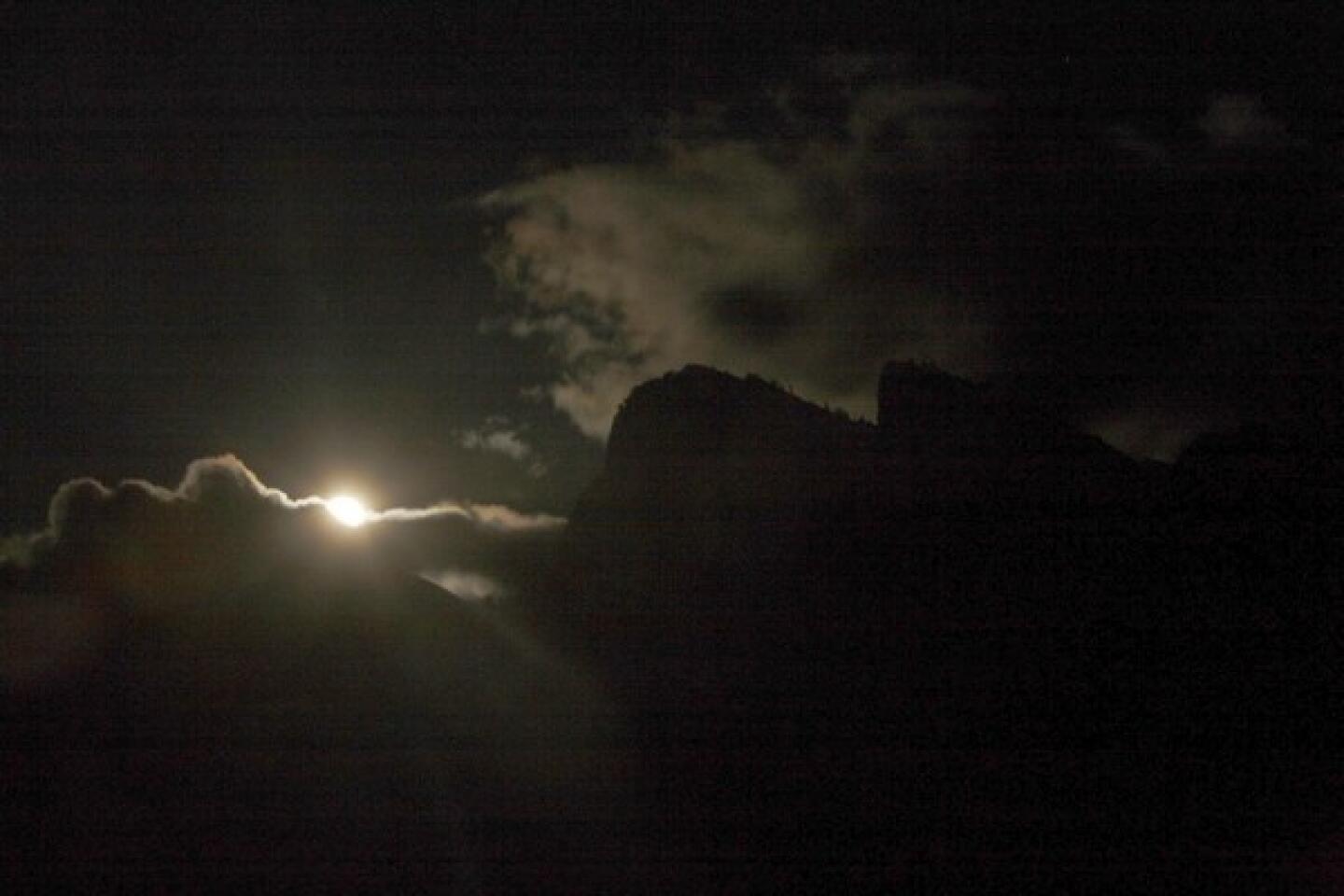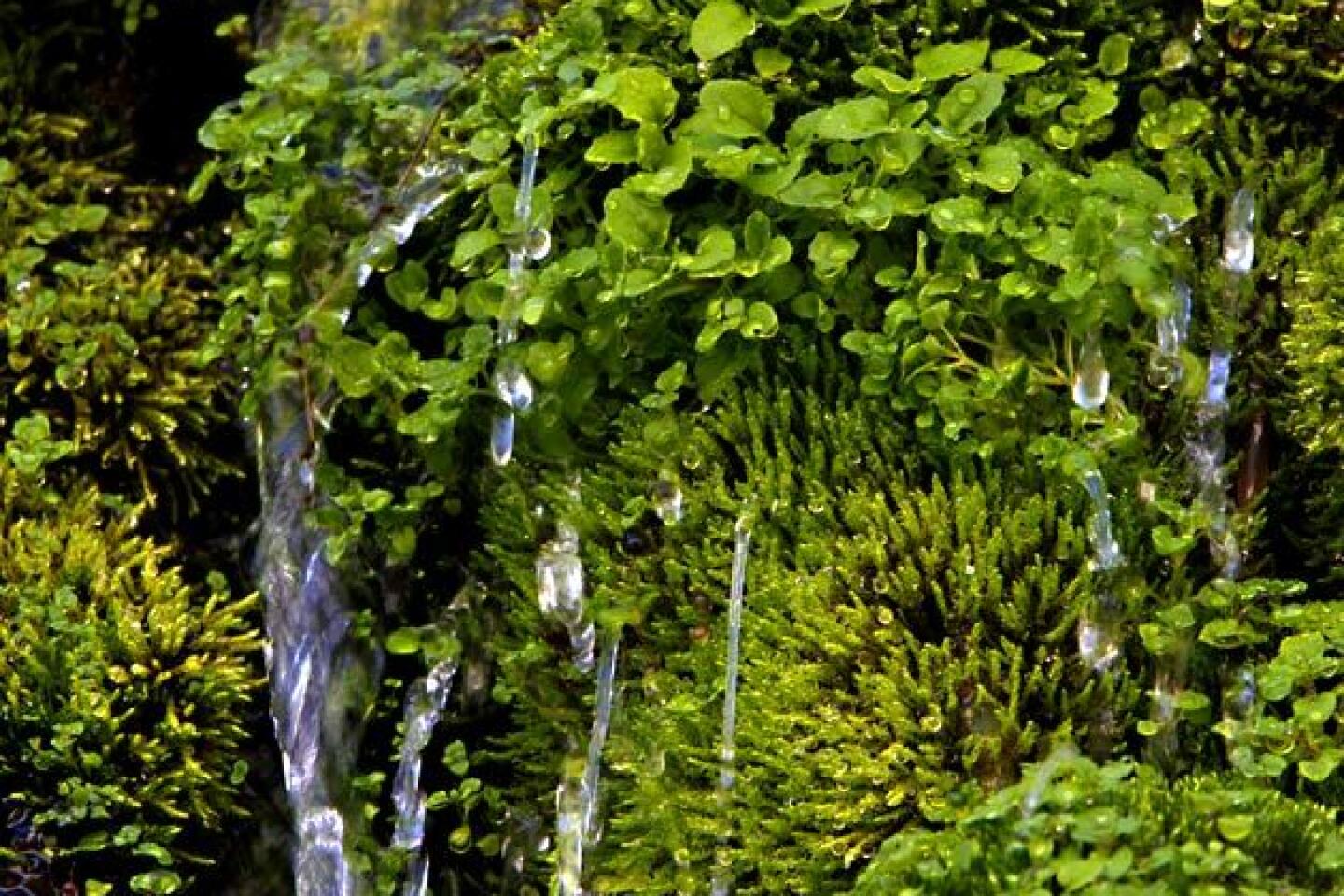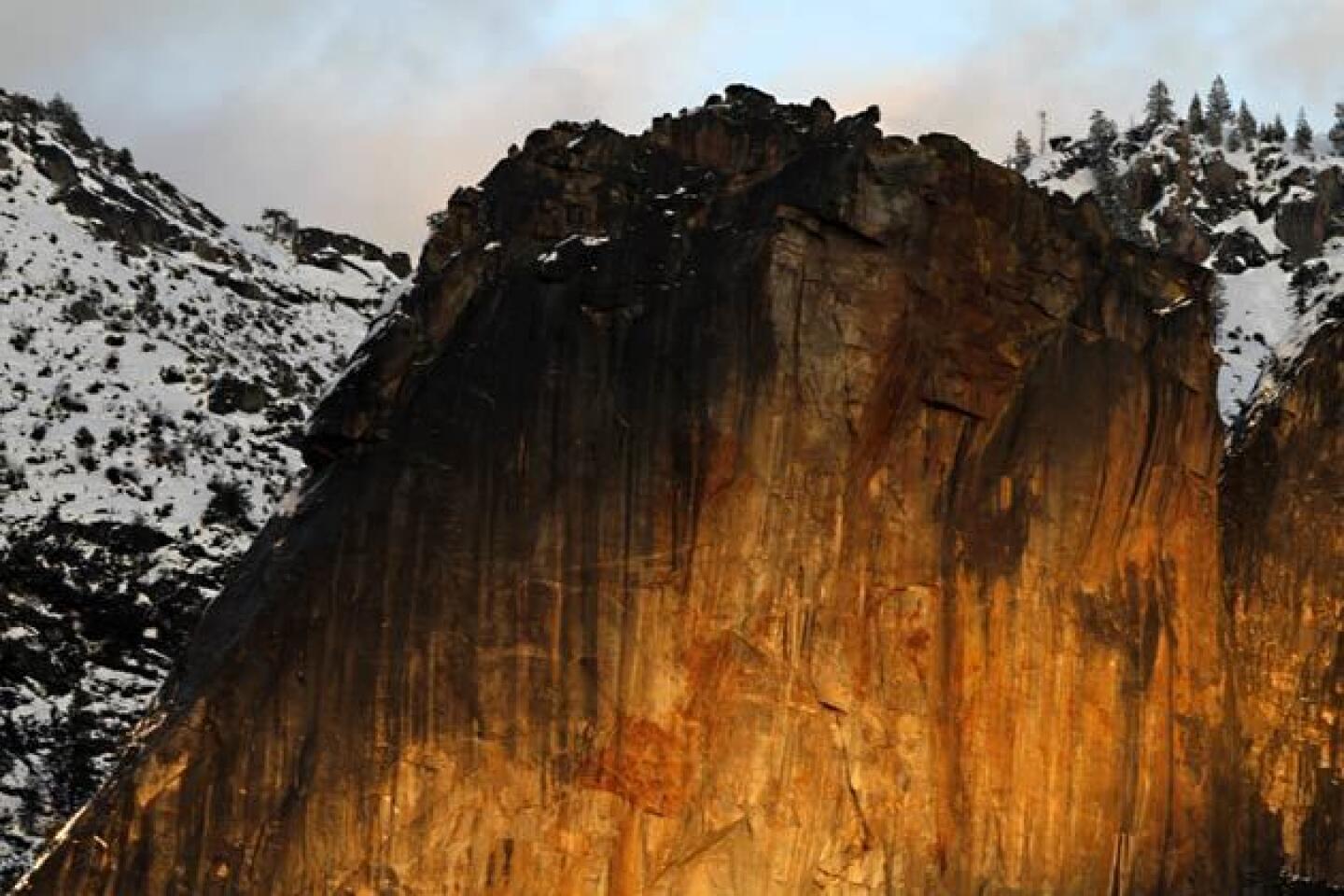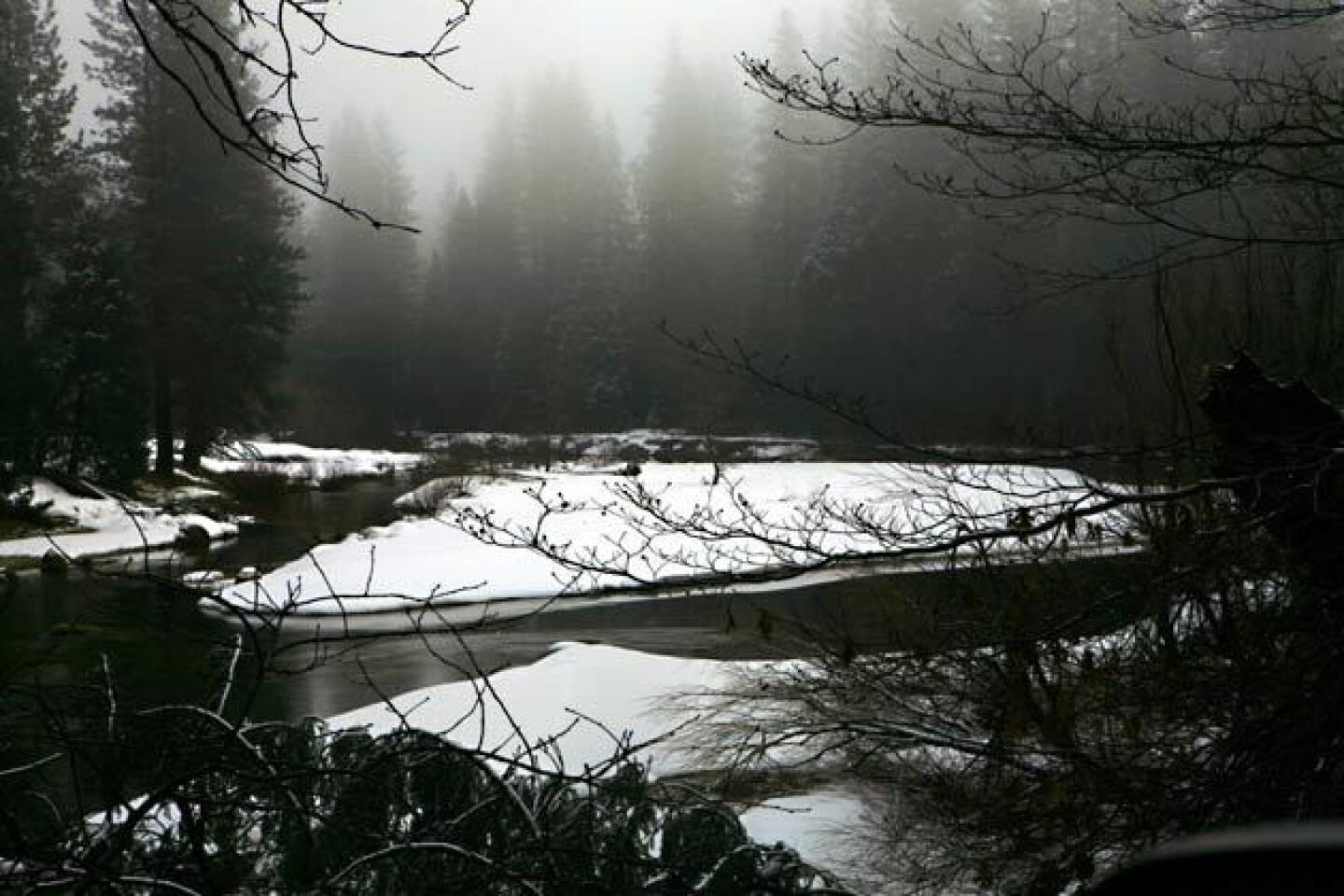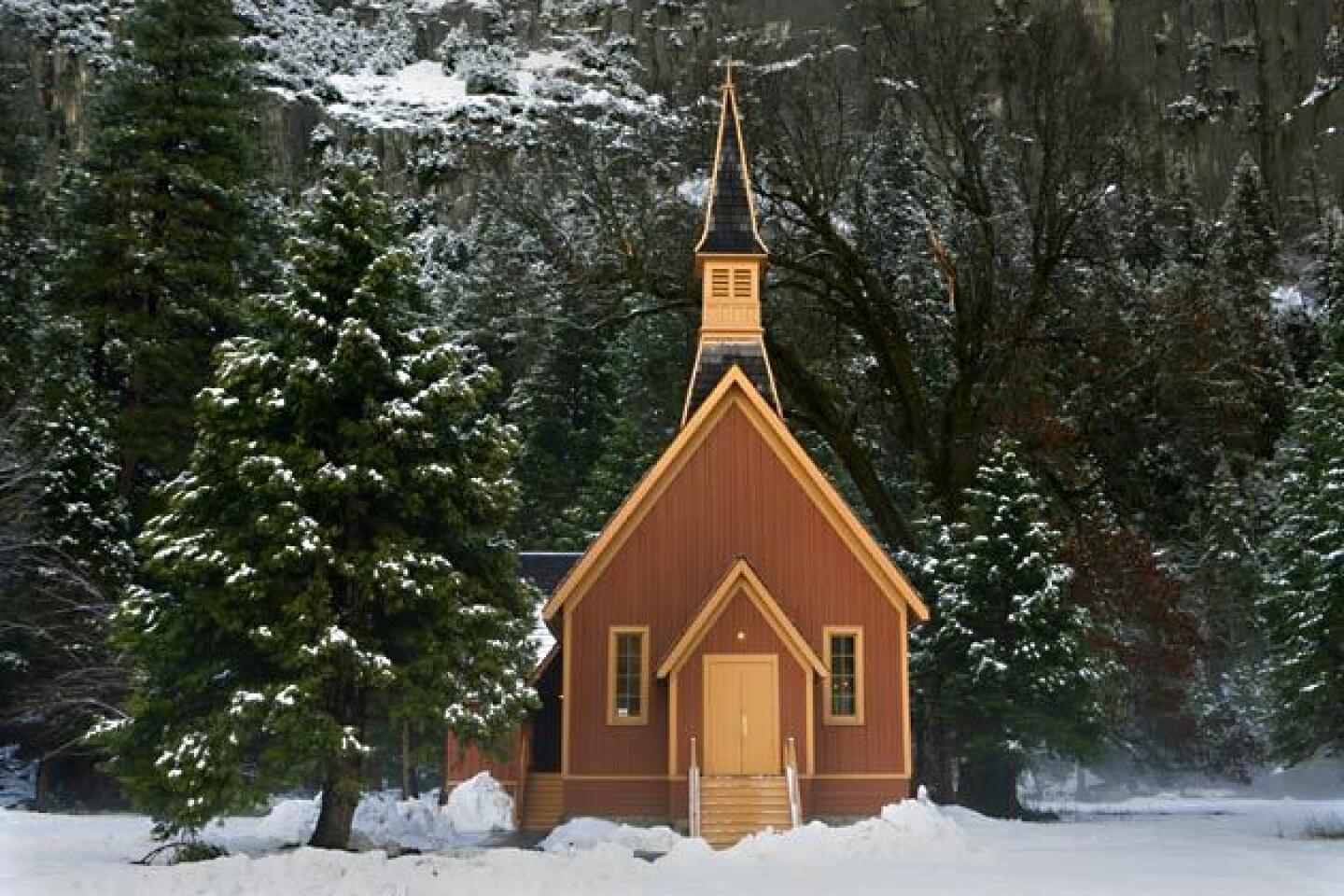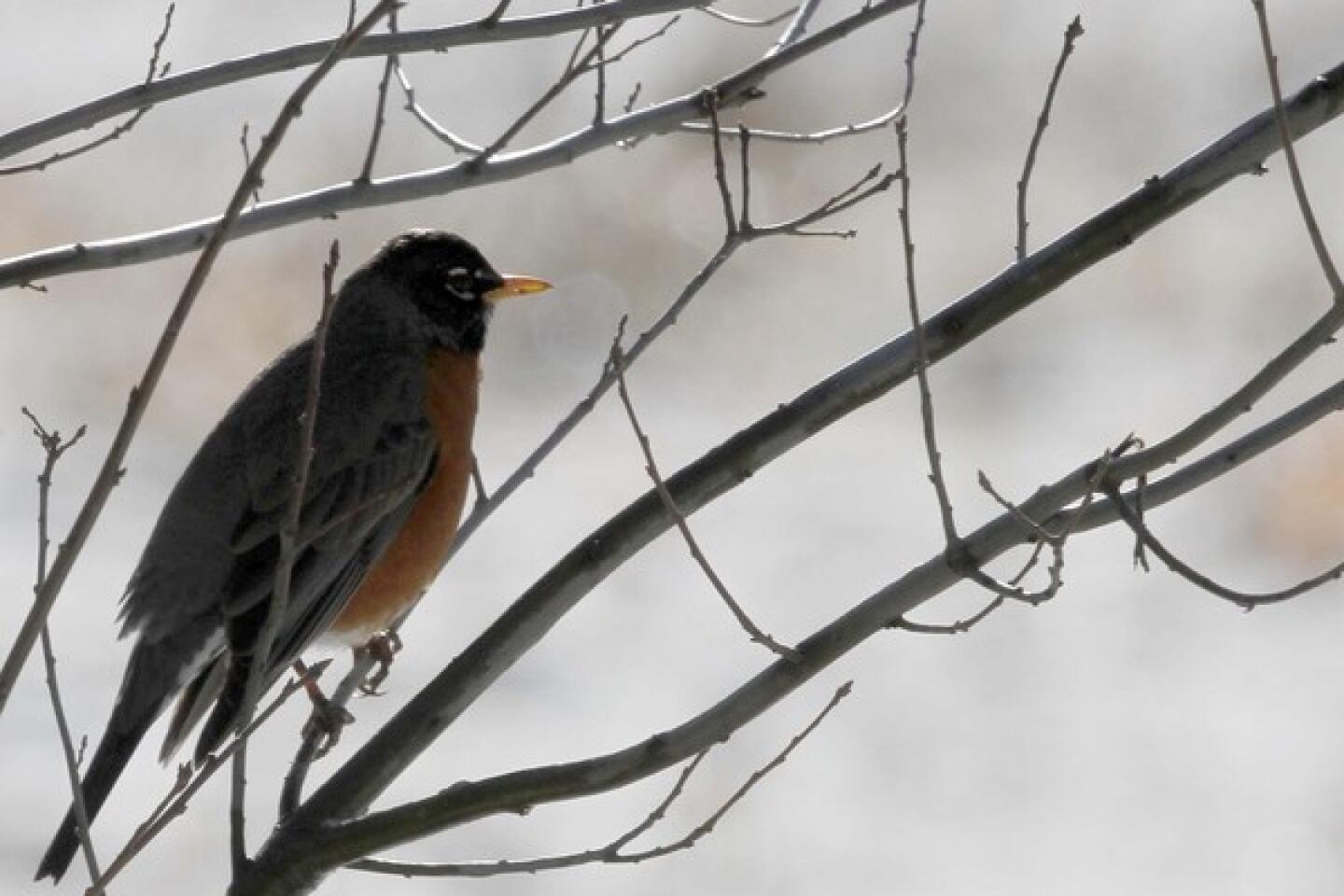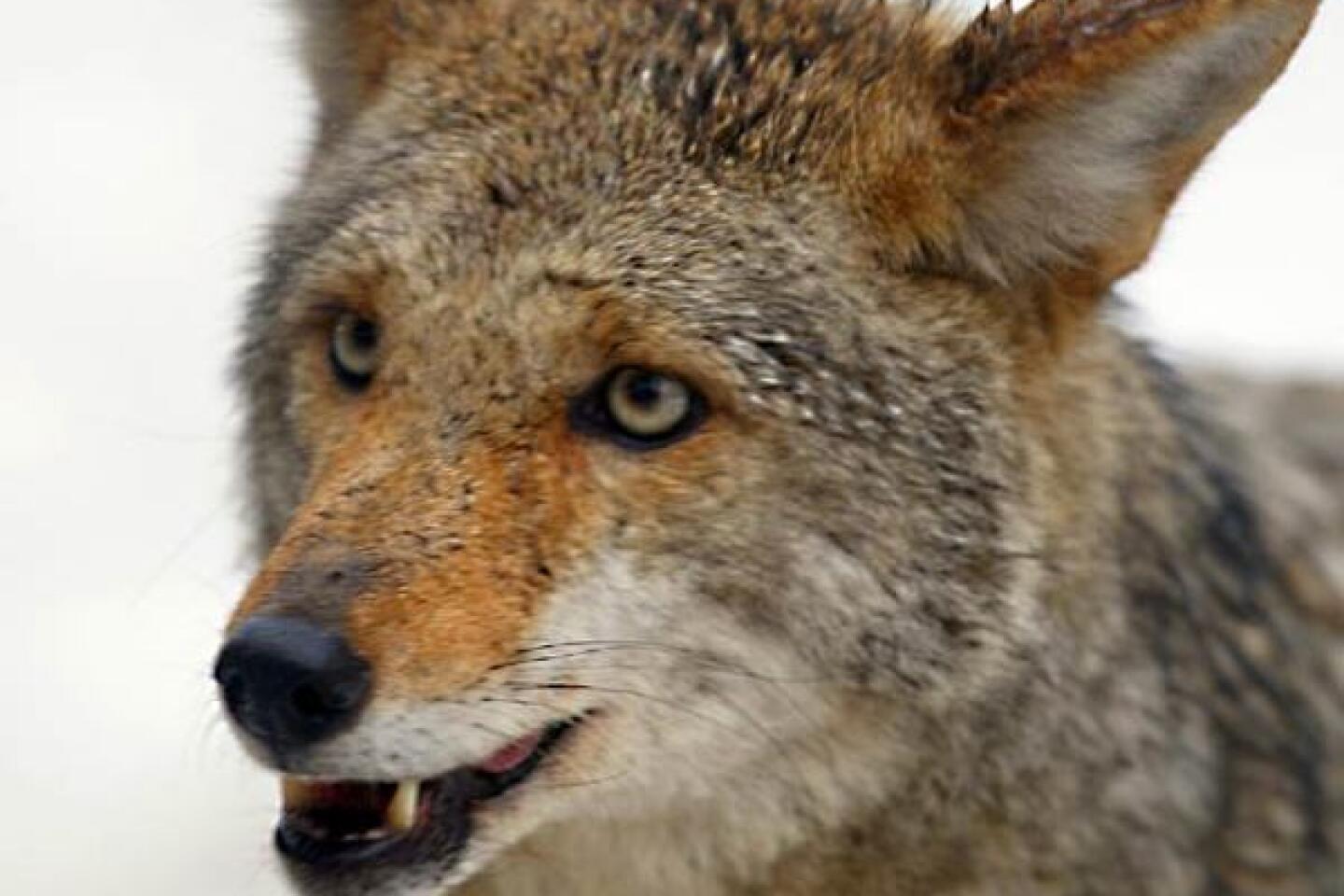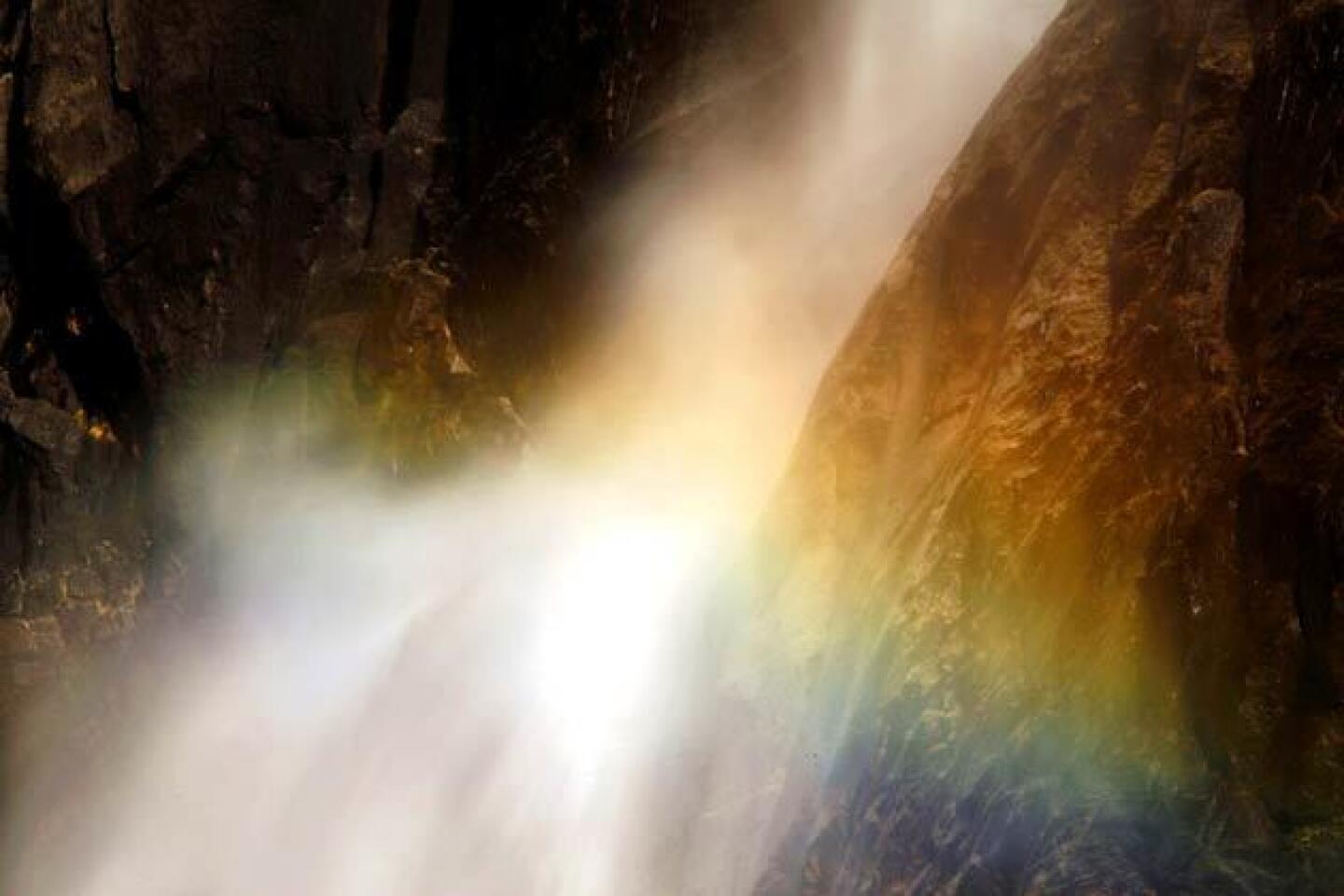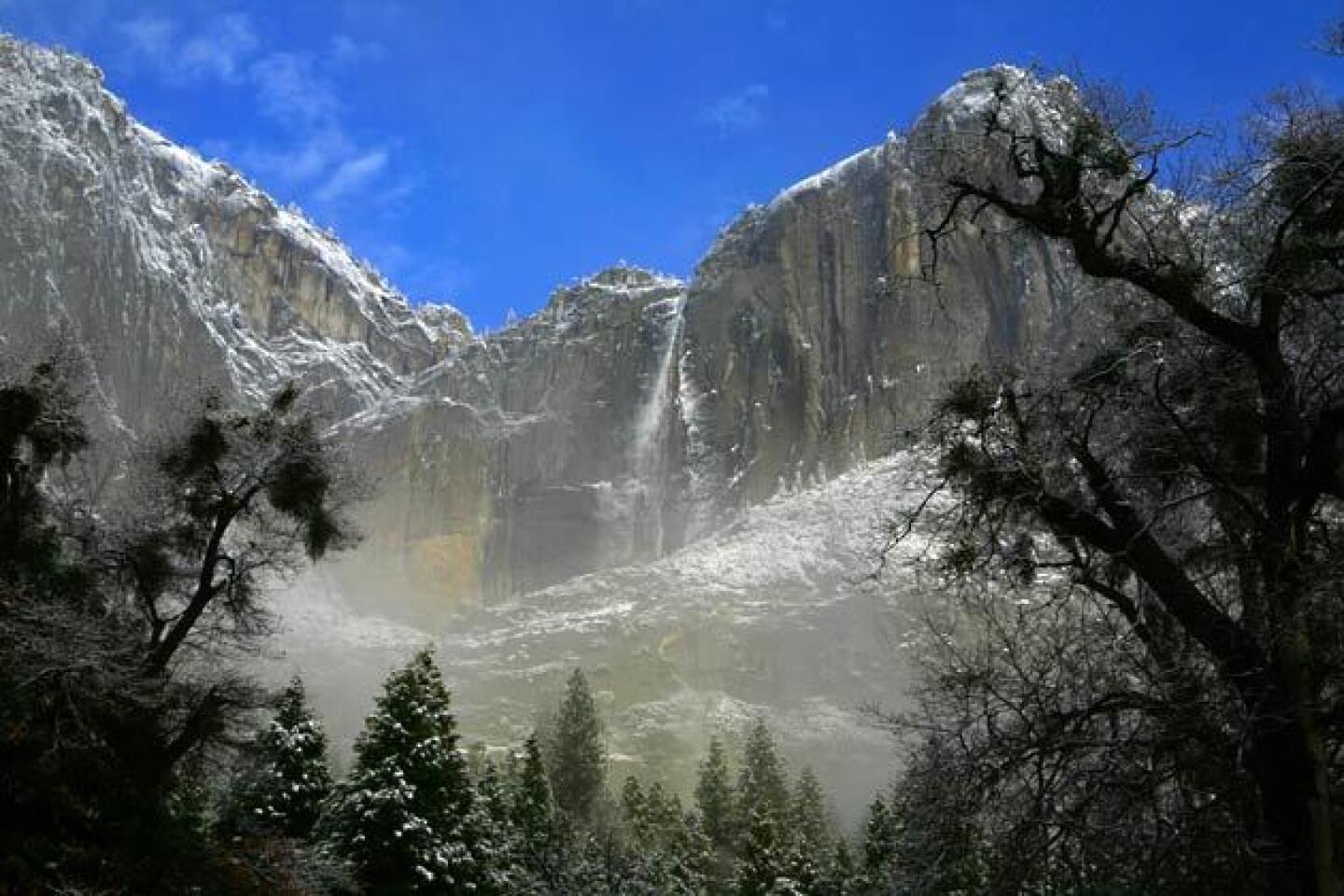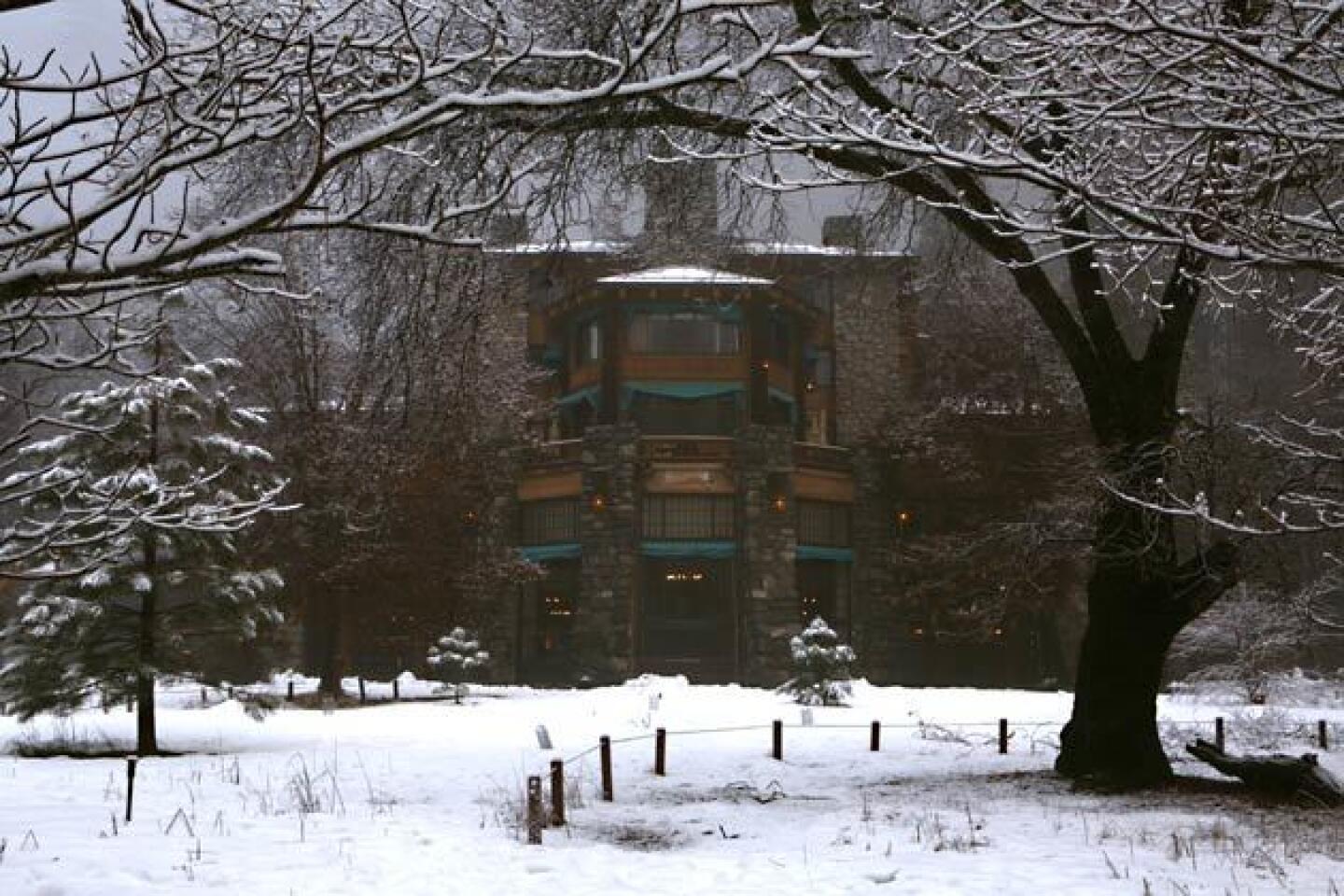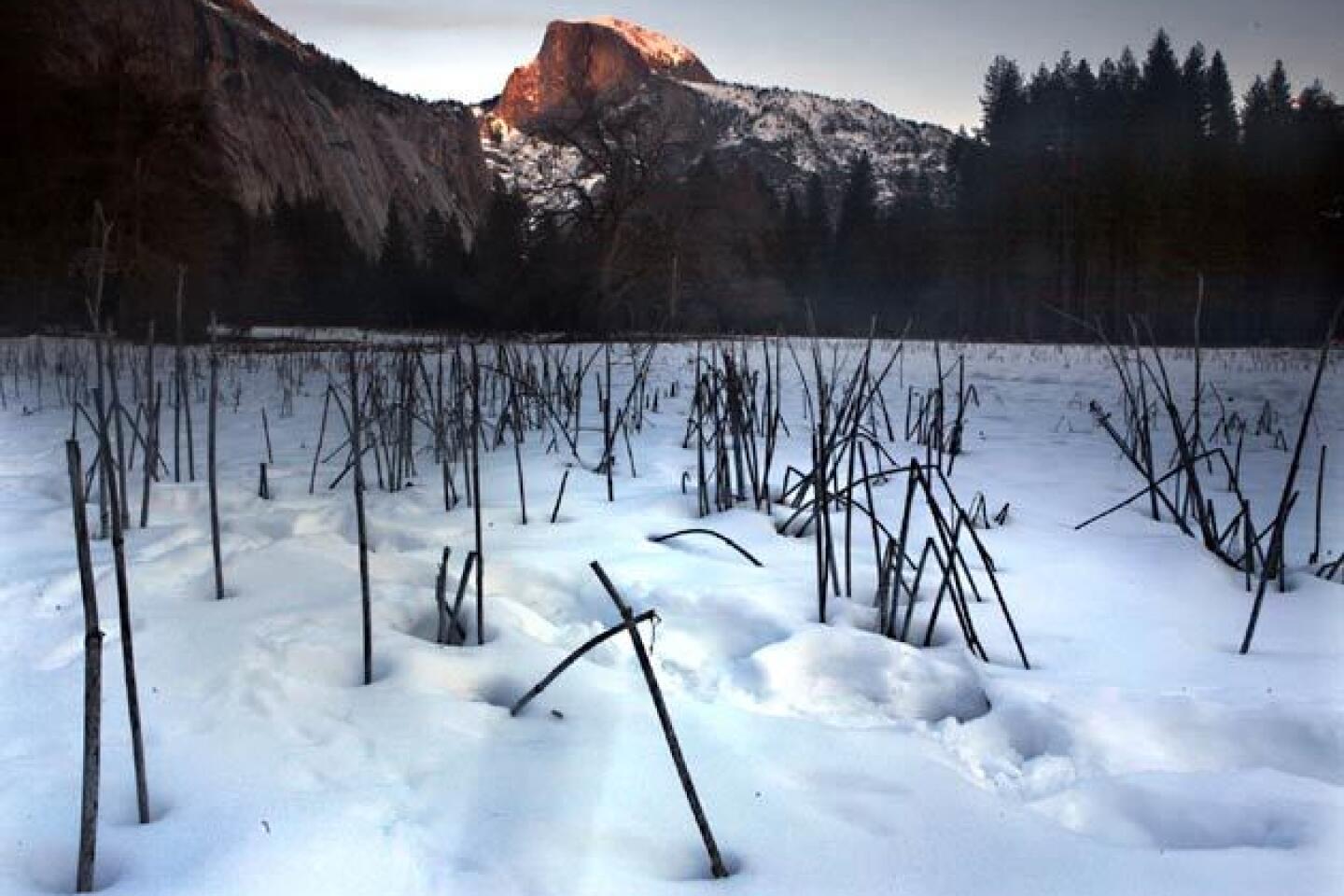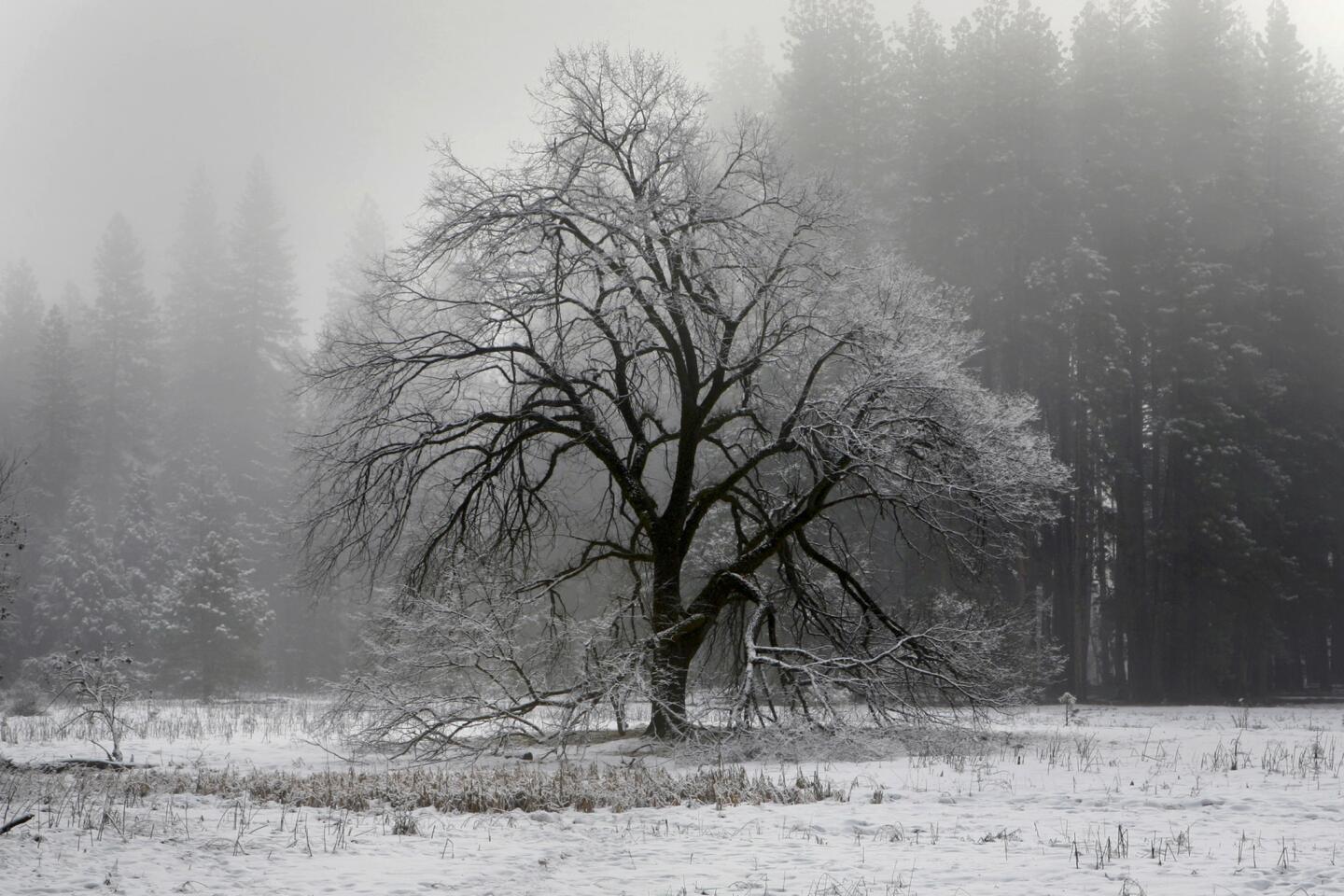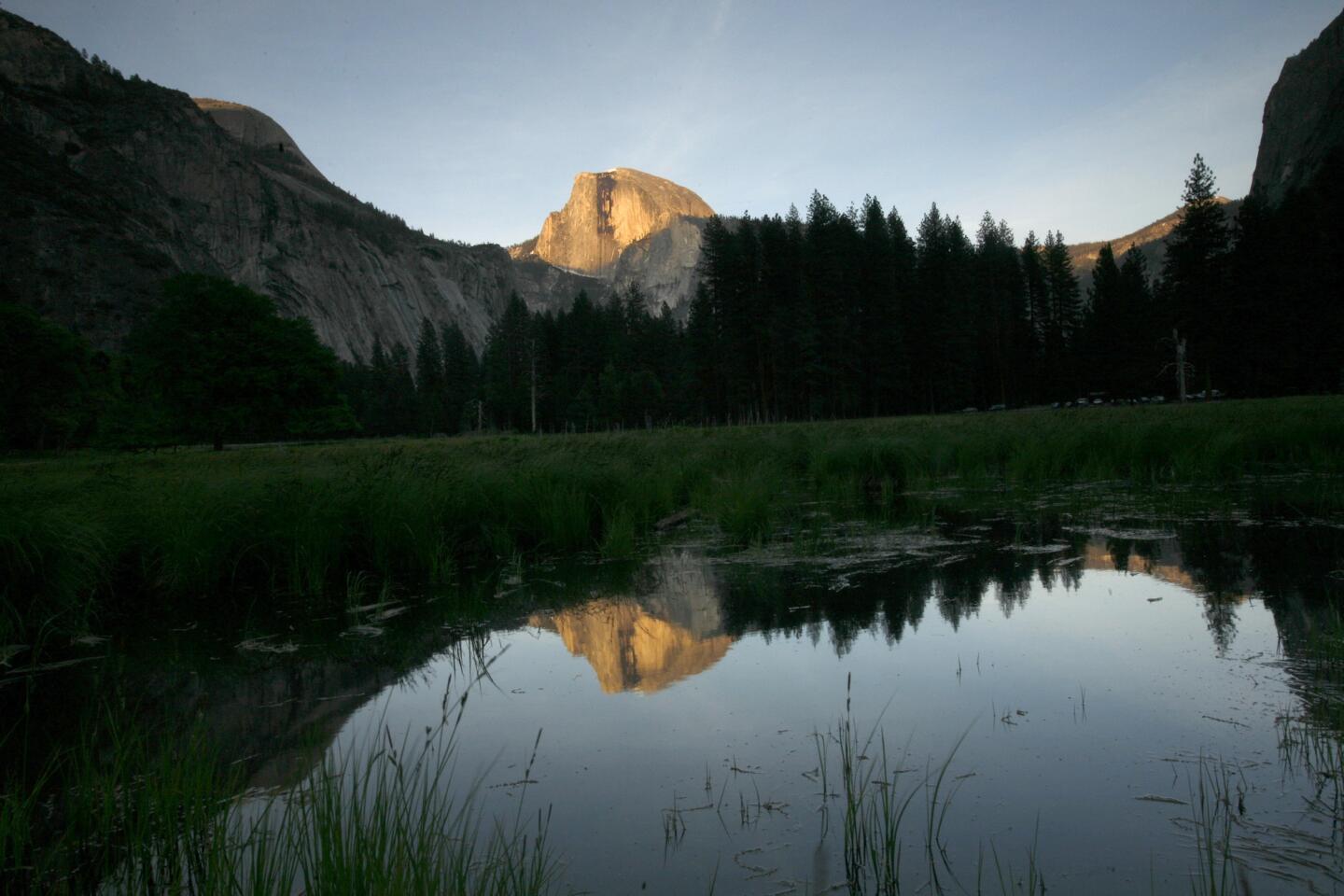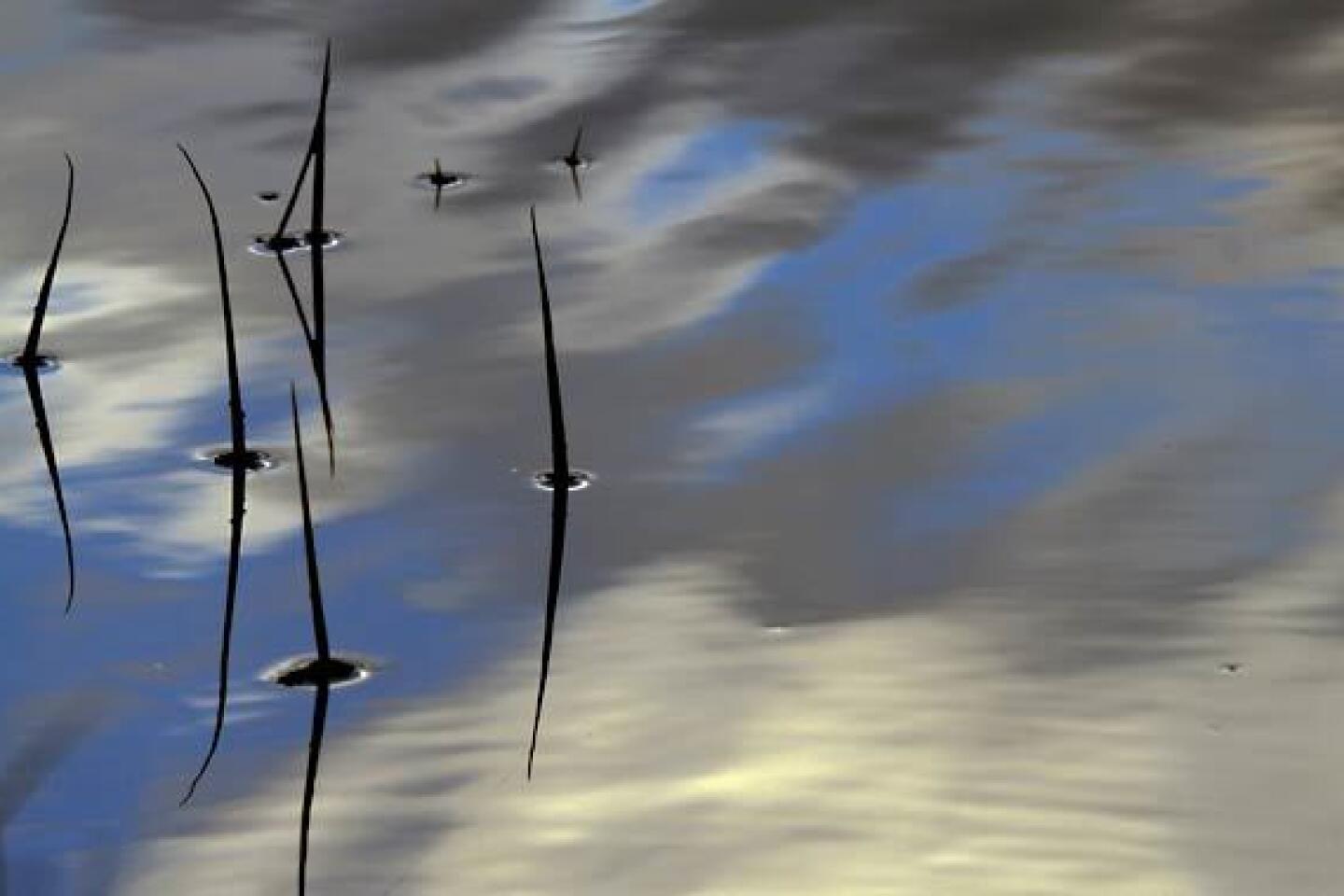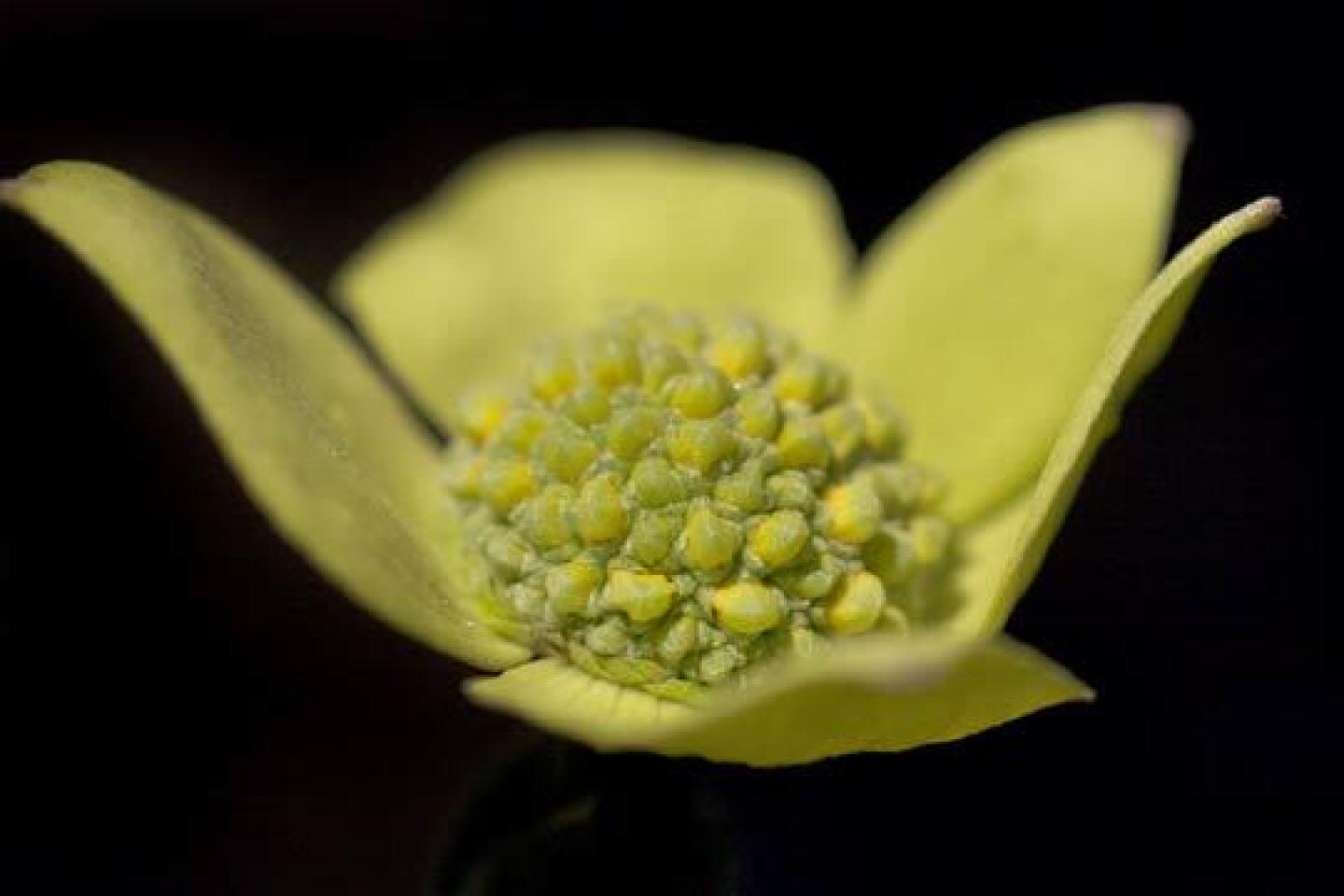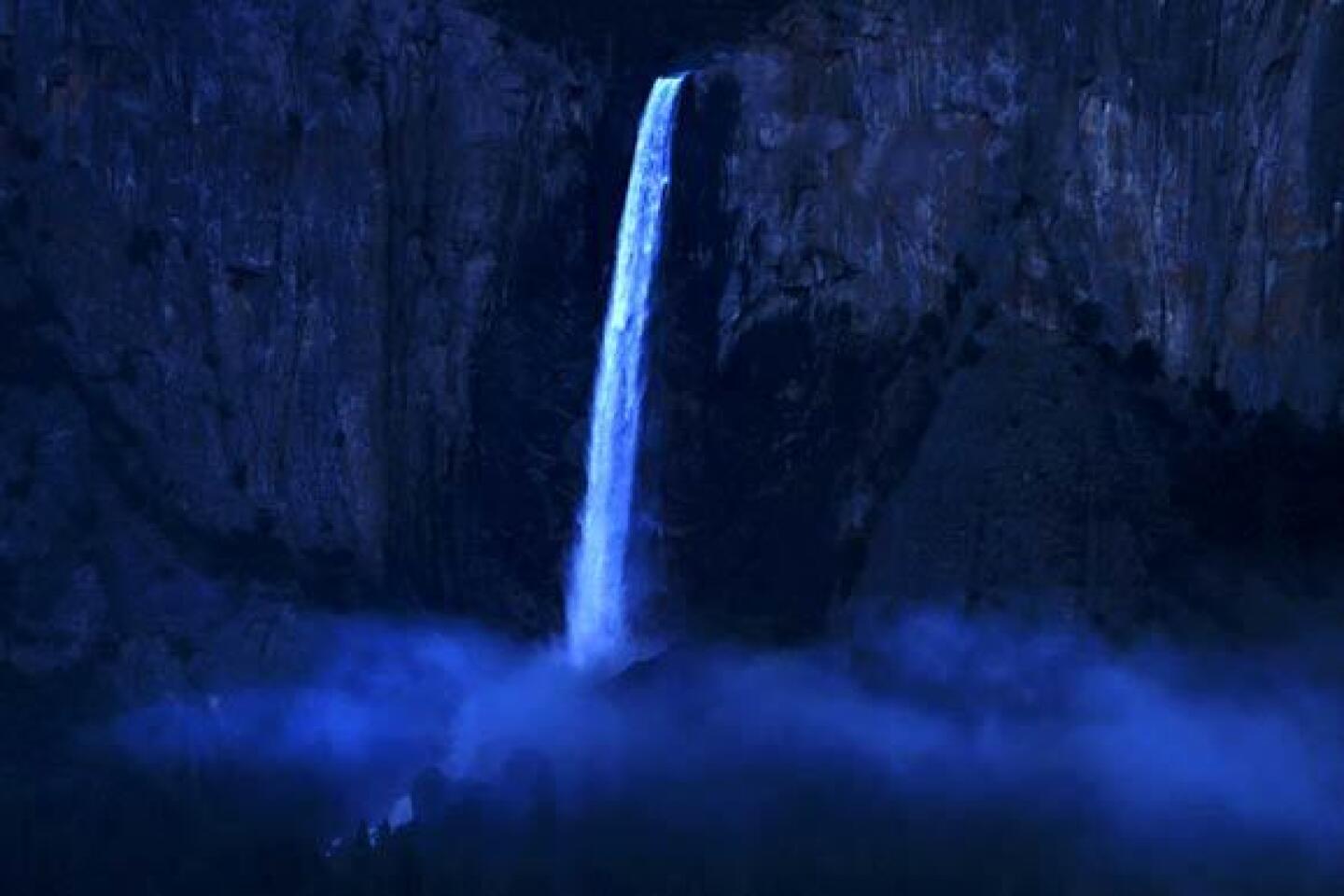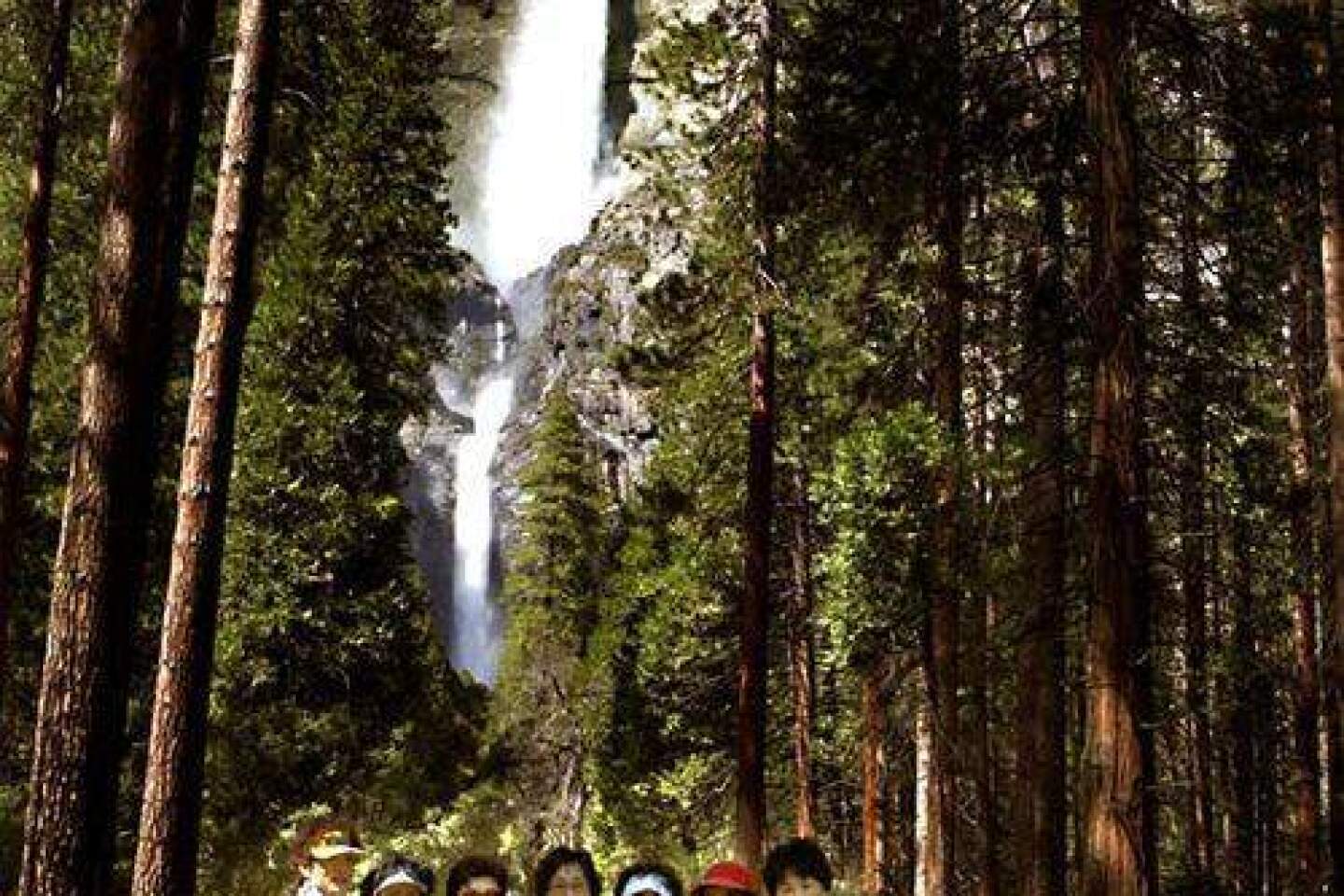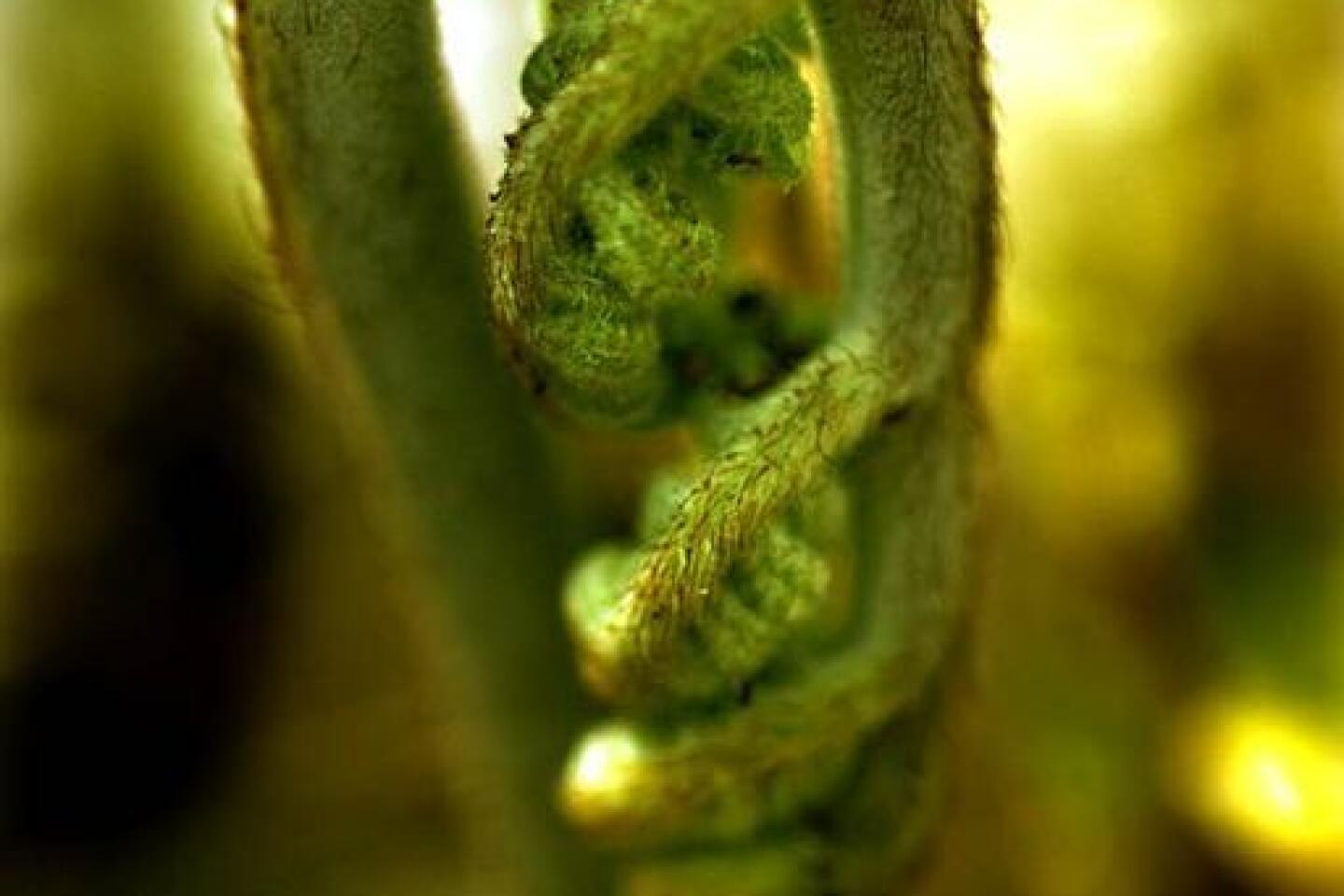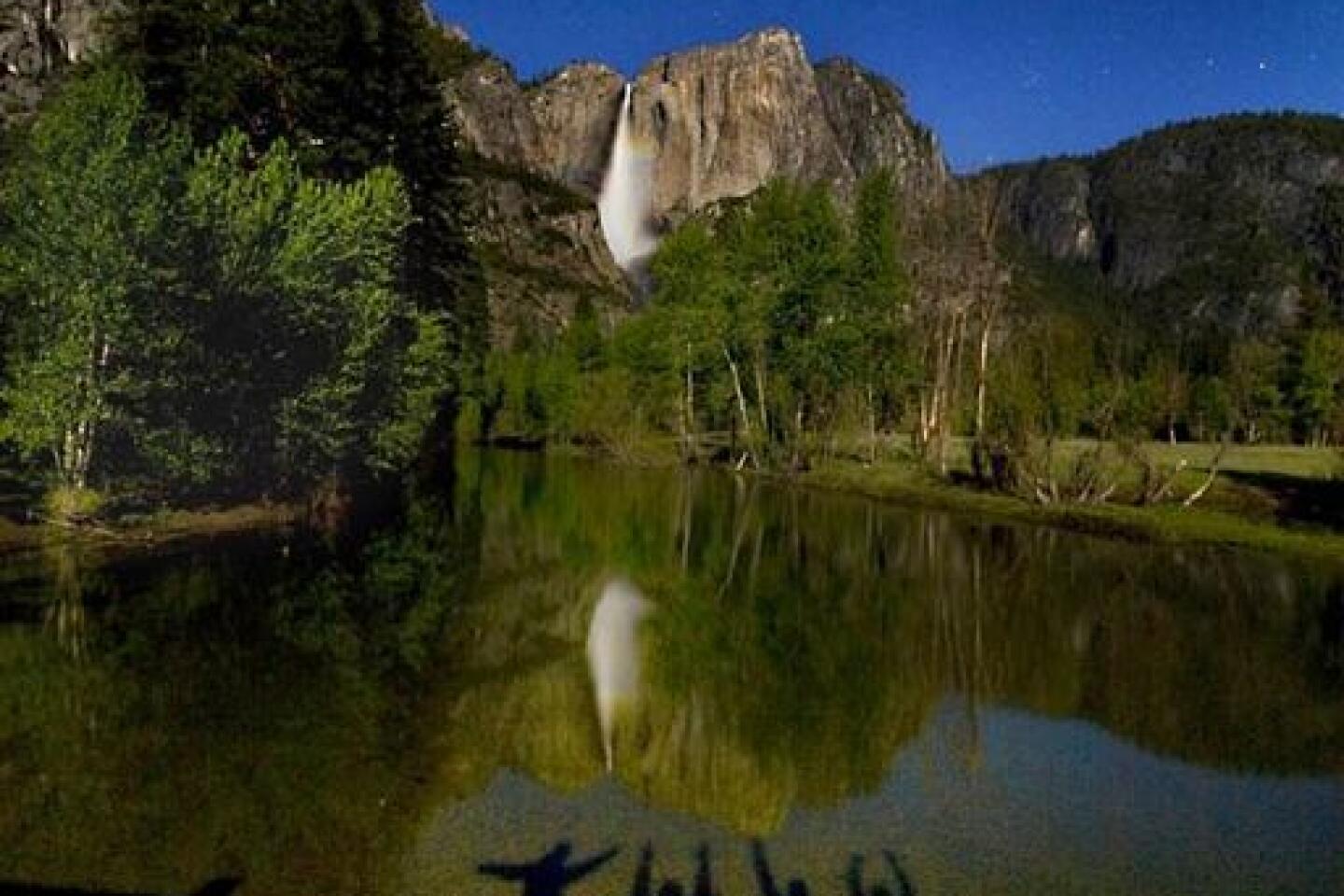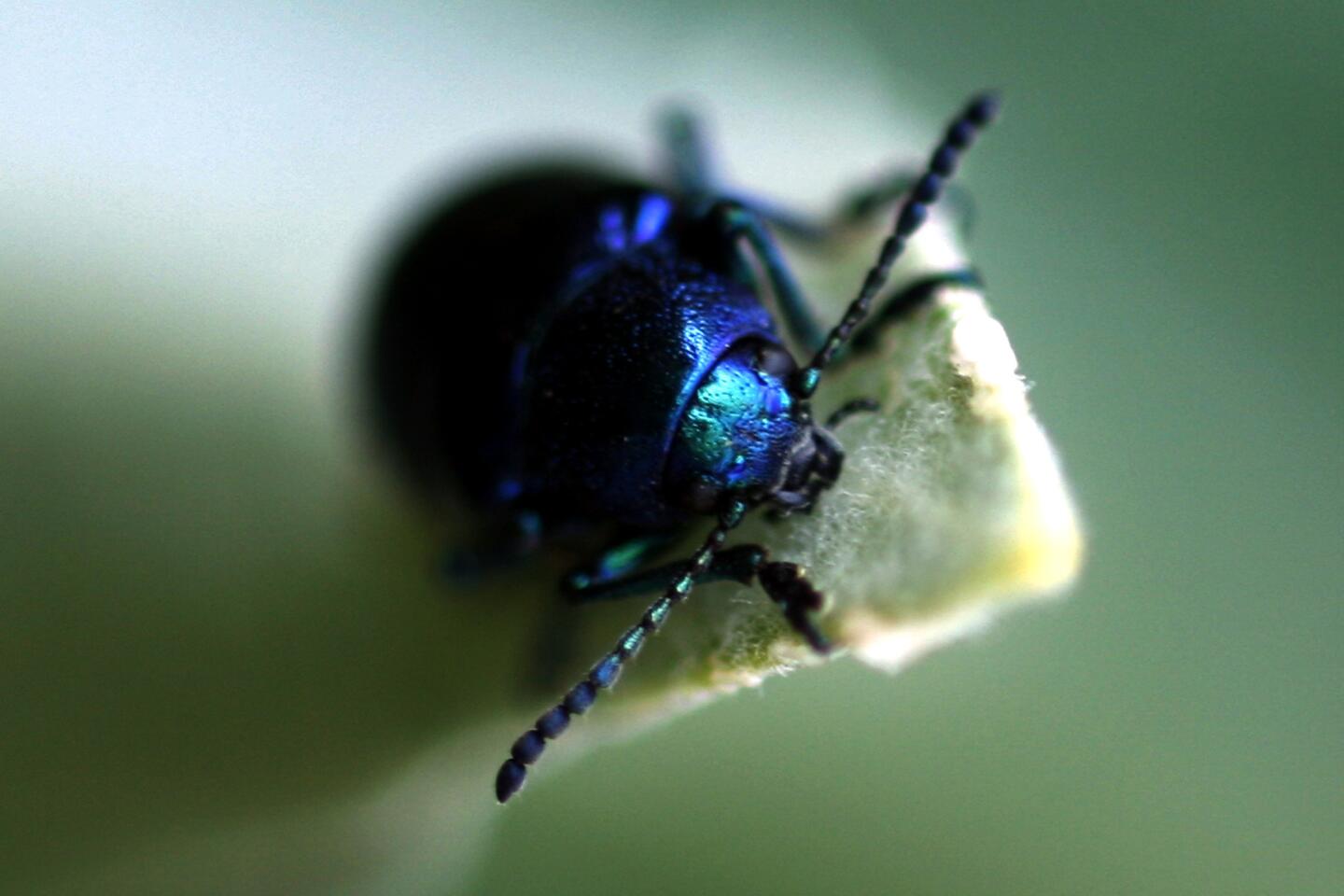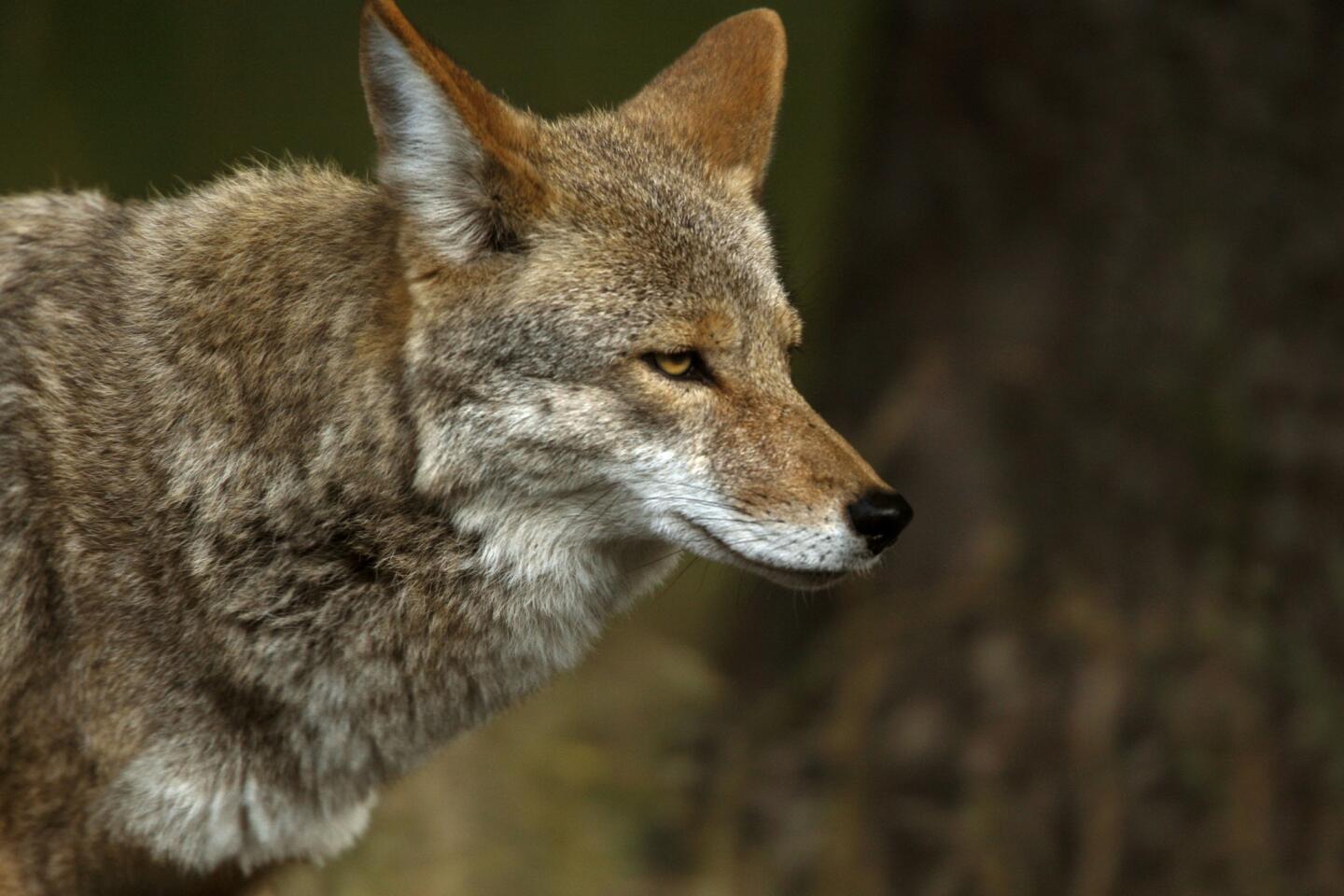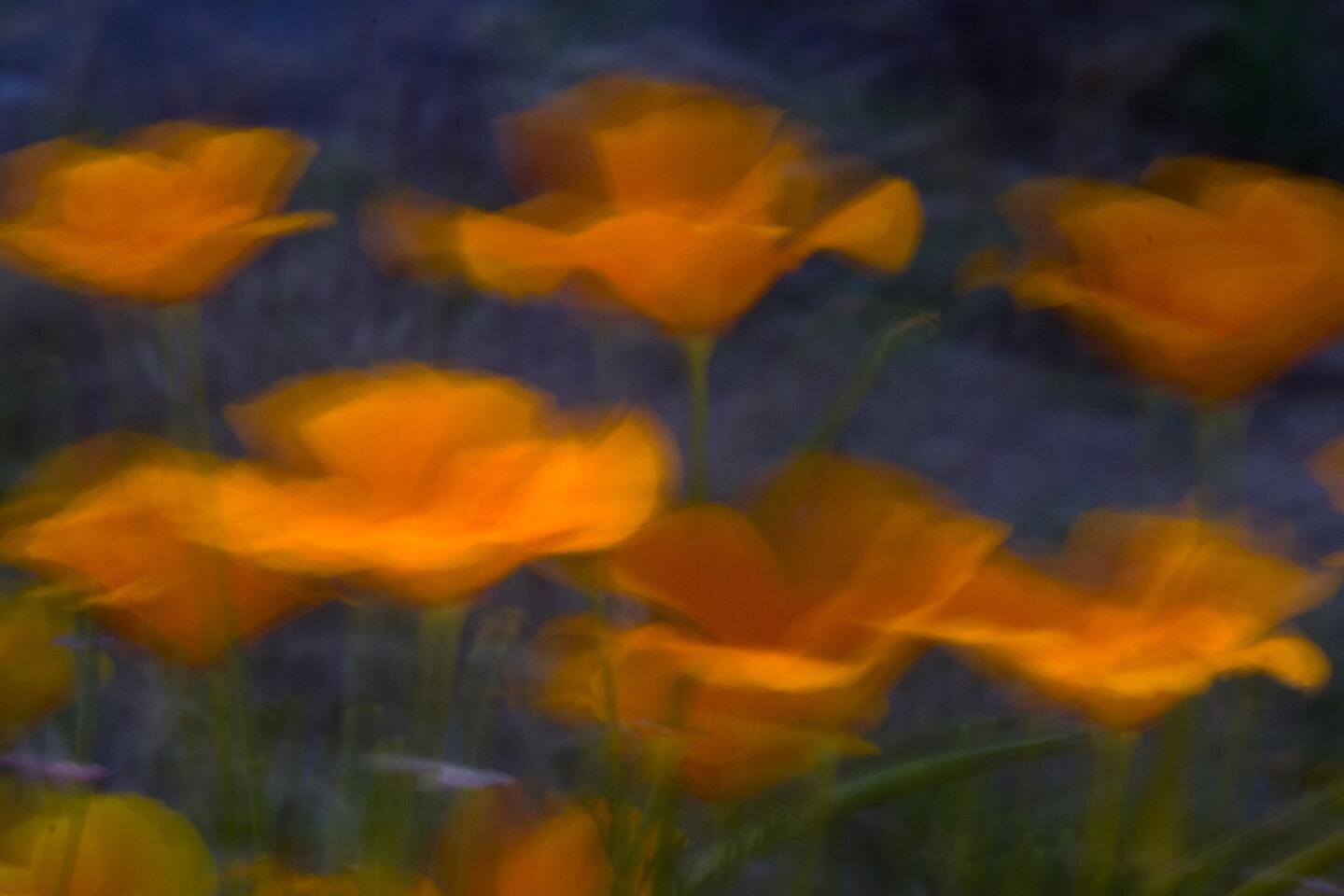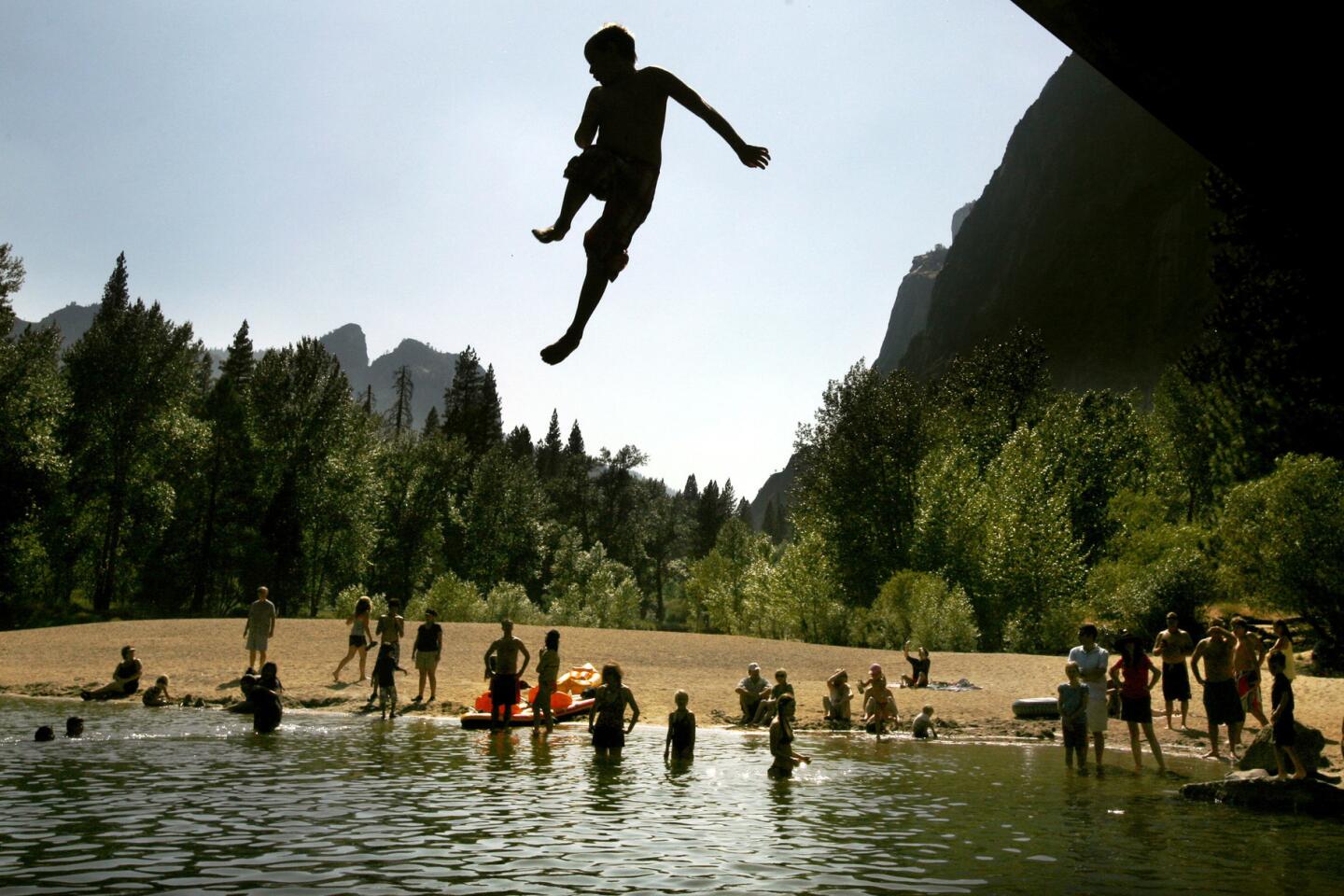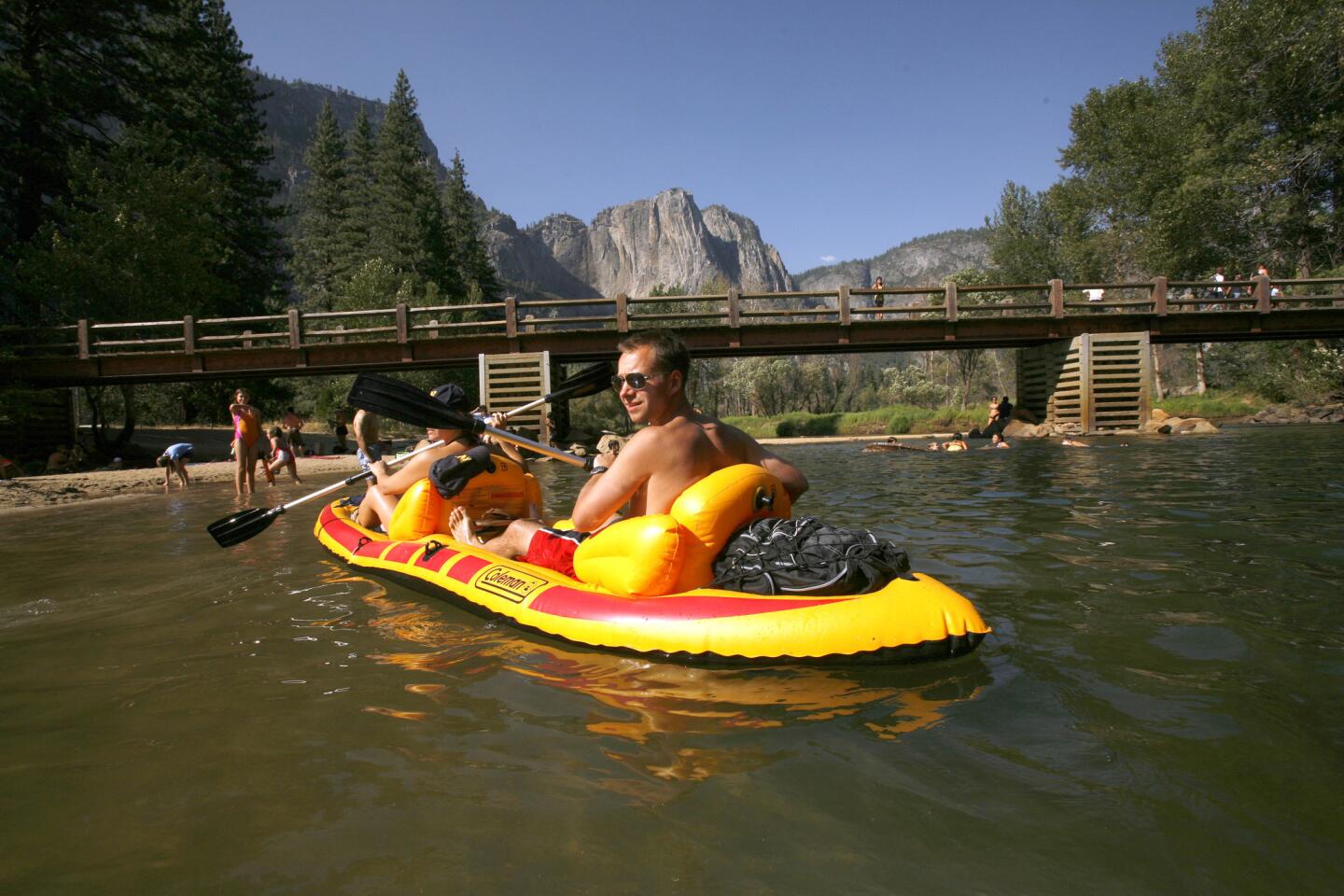Yosemite: My special place, a photographer’s journal
- Share via
Everybody has a special place where time stands still and serendipity rules. Mine is a giant granite cathedral decorated with some of the tallest waterfalls in the world. Beneath the falls lies a magical valley decorated by fields of flowing grasses and wildflowers. The air is washed clean by pine trees and aromatic cedars. A mighty river flows through it, and a magical range of light illuminates all of its features. I’m talking about Yosemite National Park.
My love of and appreciation for the beauty of Yosemite began when I was very young. My father would work for days preparing the family car (a 1950-something Pontiac) for the annual summer trips to the park. With anticipation and excitement building, several suitcases would be roped-down to the roof of the car. A canvas water bag was slung over the front chrome bumper and radiator grill; coloring books and fresh crayons were stocked inside the car; sandwiches were packed until we finally left the smoggy confines of Whittier.
With no air conditioning or seat belts, the drive through Bakersfield and Fresno could be unbearably hot and torturous. Add to that equation that my sisters were prone to getting car sick at any time -- and often did. My parents loved to stop at all of those little roadside fruit and vegetable stands along the way, and I used to wonder whether we would ever make it to the park.
But at some point we did. From the backseat, the first time I saw the grand vista of Yosemite Valley, framed perfectly by the walls and ceiling of the Wawona Tunnel, I became a disciple for life. My dad’s usual frown would turn to a smile; my mother, who taught me to appreciate art and beauty, would utter some sigh of relief; and the sisters had stopped barfing and seemed fine.
My vacation memories spent in Yosemite remain vivid: swimming in the ice-cold Merced River, hiking the Mist Trail around the waterfalls and rallying around the campfire during the nightly ranger talks. Where else could an asthmatic, dyslexic kid from the smoggy suburbs of L.A. lie down in a meadow to study wildflowers and contemplate the movements of bees and dragonflies? I had a place that seemed as if it was a million miles away from my bad math grades. Deer would wander past my canvas tent in Curry Village by day, and bears would forage by night. Indigo night skies were covered with a blanket of bright stars, and it seemed like every constellation, planet and celestial body was hovering overhead and close enough to touch.
But there’s one memory that will forever remain my favorite. After the ranger talk would wind down in the evening, everyone would turn toward a cliff high above the valley floor. Forming megaphones with their hands cupped around their mouths, a string of men would begin to yell, “Fire fall! Fire fall! Fire fall!” Moments later a giant campfire that had been stoked for hours would be pushed over the side of Glacier Point, forming a perfect red, fiery cascade of embers that would leave the crowd in awe. How could this place get any better?
Through the years, my family returned to Yosemite less and less, but I would return to establish a new tradition with my own family. Over the past 33 years, my wife, sons and I have hiked, photographed and adventured through Yosemite. We have gathered with friends and family during all of the four seasons to celebrate birthdays, Christmas, even the wedding of a dear friend.
As a young photographer starting out in the newspaper business, I studied the works of the park’s master photographer, Ansel Adams. I began photographing every rock, twig and pond I could find; Yosemite became my classroom and my obsession -- and it still is.
Understanding the light
Morning light changes from minute to minute and varies from season to season. The first rays of light start to appear behind Half Dome and gradually illuminate the granite features of the valley. It gracefully dances off the waters of Yosemite Falls, then the upper reaches of El Capitan begin to glow and shimmer. Times vary by season, but during the first hour of sun hitting the mist of Yosemite and Vernal falls, a rainbow usually encircles the base. The same effect can be seen in the later parts of the day about an hour before sunset at Bridalveil and Vernal falls, with rainbows shimmering off the mist.
Morning also is a great time to view wildlife. The low sunlight and cooler temperatures draw out grazing deer and a few of the wandering coyotes that eye them. Morning light filters gently through the trees and creates a dazzling image when it shines through the ground fog and low clouds that so frequently cover the meadows in the valley. The morning sun colors vary from warm yellow to bright orange and change, depending on things like cloud cover and the other conditions that are unique to Yosemite.
Most photographers put their cameras down during the middle part of the day and take a nap. But midday light in Yosemite provides a great time to look at wildflowers and hike through meadows looking for the “small” pictures. I use this time of day to go exploring with a macro lens. Then I map out where I want to be for that day’s sunset, combing the landscape for compositions, foregrounds, rocks and framing elements perfect for an end-of-the-day shoot.
Some photographers park themselves on the first picturesque spot they see upon entering the park, Tunnel View. So many iconic images have been made from this well-worn vantage point that offers an almost-180-degree view of the Yosemite Valley. With the help of a few passing clouds and the right atmospheric conditions, the sunsets at this spot can be phenomenal. And then there’s a bonus sunset: Even after colors recede from the sky and sunset appears to be over, a second sunset usually follows where rock features glow bright red-orange, a phenomena appropriately called alpenglow. It’s one of the great treats of the Sierra Nevada and a gift to patient photographers. Valley View, another sunset spot, provides a low level view of El Capitan, Cathedral Rocks and Bridalveil Fall, with the Merced River providing the lower part of the frame and the skies above forming the upper frame. This location has been used so many times that the holes in the sand formed by tripod legs are almost petrified. I also like Glacier Point and nearby Washburn Point, where you can see Vernal and Nevada falls and get a great side view of Half Dome.
The shape of the valley lends itself to many different forms of night photography. I have spent many quiet hours studying the stars and using very long exposures to capture the light. On a cloudless night, the canyon walls will light up from what little ambient light is available and the stars. Details in the rock faces will be visible with the help of just a sliver of the moon. During a full moon in February once, I stood on a thin sheet of snow and ice at Tunnel View for several hours, waiting to see what the moon would do. I was bundled by three thermal layers and wore a pair of snow shoes, but the wind still blew through me. As the moon rose, the sound of camera shutters broke the silence. A fogbank that had been hovering on the valley floor became illuminated so brightly night became day. The valley came into clear view, and cameras continued to click and whir. Then, just as quickly, the moon retreated behind the clouds and disappeared.
Photographers who know the turf
After 35 years as a professional photographer, I continue to be inspired and amazed by Yosemite. There have been so many great photographers who have followed in the giant footsteps of Ansel Adams and have taken his teachings and examples to new heights. Yosemite is a breeding ground for some of the most talented landscape photographers in the world. Resident photographer Nancy Robbins made one of my favorite pictures of a moonbow at the base of Yosemite Falls, perfectly aligned with the Big Dipper. She may not have been the first to photograph a moonbow, but hers is one of the most incredible images made of the phenomena of the light. Michael Frye has made some amazing images around the park, demonstrating his expertise with alpenglow, sunsets and pictures throughout the four seasons. Frye produced a must-have pocket-sized book, “The Photographer’s Guide to Yosemite.” With examples of Frye’s work, photographers shooting pictures in the park turn to the book for helpful hints about light and locations, and a great listing in the appendix shows the sun and moon tables.
The four seasons
Spring: When I started this project in spring, rivers were flowing to capacity and waterfalls were crashing so hard on the rocks that it sounded like dynamite charges were going off. The water produced from an El Nino year can be furious and powerful but, oh, so beautiful.
After I’d hiked to the base of Bridalveil and Yosemite falls, a strong mist almost blew me over. My clothes were soaked, and my cameras started to fail. To compliment the water show, wildflowers start blooming, first the lupine at the lower elevations around Wawona begin to show their purple heads, then some of the other 1,497 flowering species in the park begin to emerge from their winter nap. The most famous flower in the park has to be dogwood.
Many photographers and tourists plan their visits to the park just to see the delicate, white flowers that bloom along the banks of the Merced River and that usually start budding in April and bloom in mid-May. You can find spectacular displays around the Pohono Bridge. By late spring, the crowds start to take over, and the park can become a nightmarish traffic snarl. But the nights are cool, and the days are very comfortable. An occasional rainstorm can be accompanied by a little snow all the way through Memorial Day.
Summer: Temperatures start to rise, the days get a little longer and the visitors swell to capacity. The number of people almost overwhelms the beauty of the park. When heat hits 80 or 90 degrees, it’s best to take a long hot hike to a waterfall or dangle your feet in the ice-cold river. Wildflowers continue to bloom, the grasses in Cook’s Meadow start to grow tall, and trees with broad leaves are bright green. The roads leading to Glacier Point and Tioga Pass are now open, and visitors can explore the high country that had been closed most of the year.
Fall: Finally, the crowds start to dwindle, the days get shorter and the leaves begin to turn. Some trees turn quickly and die while others make a slow transition. By mid-October, the giant maple tree across from the chapel on Southside Drive is glowing bright red. A light rain is coating the perfectly shaped leaves with a clear glaze that accentuates the colors. Stand underneath the tree and look outward, and the light shines through the leaves, creating a beautiful show of color. A short walk away, almost within view of the maple tree, a giant elm tree in Cook’s Meadow is turning shades of yellow and orange. Around the park, leaves begin to blanket the ground and cover the grasses that had grown so tall during spring and summer.
Winter: Winter is the extreme quiet time, with few visitors and fabulous discounts at the lodges in the valley. On Super Bowl Sunday, I was standing in the meadow near Swinging Bridge, and the only noises I could hear were the wails of a distant coyote and the wind blowing through the trees. There was only one other human about. I could hear the crunching of his boots through the snow before I saw him. The scene was completely colorless, stark, leafless trees contrasting with the snow showed only shades of black and white.
A lifelong fascination
I will never lose my enthusiasm for Yosemite. It is a place where I can practice my photography and refine my skills on the ever-changing landscape and dazzling range of light that’s both a challenge and a gift. With photography comes the ability to preserve the beauty and to share the view with others.
Any walk treads the same paths and passes under the same trees that Native Americans did centuries before trappers and explorers discovered them. This valley of granite with its waterfalls, rivers and spires carved by glaciers is nothing short of a giant cathedral and a holy place where evidence of an amazing creator is all around.
I do not consider myself an expert on Yosemite. Many photographers out there have mastered the light and conquered the terrain. Luckily, the light and colors will continue forever. The park and all its glory will live on in photos. As a student of this magnificent park, I feel as though I have a lifetime to perfect my craft and to master my visions. I am proud to be able to share some of my pictures and to pursue a lifelong dream that started in a hot car nearly 50 years ago with my family.
More to Read
Sign up for The Wild
We’ll help you find the best places to hike, bike and run, as well as the perfect silent spots for meditation and yoga.
You may occasionally receive promotional content from the Los Angeles Times.
